| Web
and Book design,
Copyright, Kellscraft Studio 1999-2010 (Return to Web Text-ures) |
Click
Here to return to
Japanese Homes and their Surroundings Content Page Return to the Previous Chapter |
 (HOME)
|
|
CHAPTER III.
INTERIORS. GENERAL
DESCRIPTION. PLANS. MATS. SLIDING SCREENS. FUSUMA.
TOKONOMA. CHIGAI-DANA. TEA-ROOMS. KURA. CEILINGS. .
WALLS. RAMMA. WINDOWS. PORTABLE SCREENS.
THE interior of a Japanese house is so simple in its construction, and so unlike anything to which we are accustomed in the arrangement of details of interiors in this country, that it is difficult to find terms of comparison in attempting to describe it. Indeed, without the assistance of sketches it would be almost impossible to give a clear idea of the general appearance, and more especially the details, of Japanese house-interiors. We shall therefore mainly rely on the various figures, with such aid as description may render. The first thing that impresses one on entering a Japanese house is the small size and low stud of the rooms. The ceilings are so low that in many cases one can easily touch them, and in going from one room to another one is apt to strike his head against the kamoi, or lintel. He notices also the constructive features everywhere apparent, in the stout wooden posts, supports, cross-ties, etc. The rectangular shape of the rooms, and the general absence of all jogs and recesses save the tokonoma and companion recess in the best room are noticeable features. These recesses vary in depth from two to three feet or more, depending on the size of the room, and are almost invariably in that side of the room which runs at a right angle with the verandah (fig. 96); or if in the second story, at a right angle with the balcony. The division between 'the recesses consists of a light partition, partly or wholly closed, which generally separates the recesses into two equal bays. The bay nearest the verandah is called the tokonoma. In this recess hang one or two pictures, usually one; and on its floor, which is slightly raised above the level of the mats of the main floor, stands a vase or some other ornament. The companion bay has usually a little closet or cupboard closed by sliding screens, and one or two shelves above, and also another long shelf near its ceiling, all closed by sliding screens. At the risk of some repetition, more special reference will be made farther on to these peculiar and eminently characteristic features of the Japanese house. 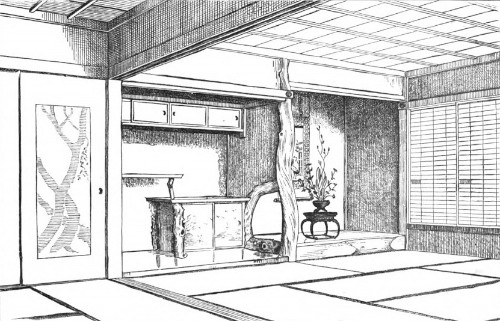 96. GUEST-ROOM AT HACHI-ISHI In my remarks on Japanese house-construction, in Chapter I., allusion was made to the movable partitions dividing the rooms, consisting of light frames of wood covered with paper. These are nearly six feet in height, and about three feet in width. The frame-work of a house, as we have already said, is arranged with special reference to the sliding screens, as well as to the number of mats which are to cover the floor. In each corner of the room is a square post, and within eighteen inches or two feet of the ceiling cross-beams run from post to post. These cross-beams have grooves on their under side in which the screens are to run. Not only are most of the partitions between the rooms made up of sliding screens, but a large portion of the exterior partitions as well are composed of these light and adjustable devices. A house may have a suite of three or four rooms in a line, and the outside partitions be made up entirely of these movable screens and the necessary posts to support the roof, these posts coming in the corners of the rooms and marking the divisions between the rooms. The outer screens are covered with white paper, and when closed, a subdued and diffused light enters the room. They may be quickly removed, leaving the entire front of the house open to the air and sunshine. The screens between the rooms are covered with a thick paper, which may be left plain, or ornamented with sketchy or elaborate drawings. The almost entire absence of swinging doors is at once noticeable, though now and then one sees them in other portions of the house. The absence of all paint, varnish, oil, or filling, which too often defaces our rooms at home, is at once remarked; and the ridiculous absurdity of covering a good grained wood-surface with paint, and then with brush and comb trying to imitate Nature by scratching in a series of lines, the Japanese are never guilty of. On the contrary, the wood is left in just the condition in which it leaves the cabinet-maker's plane, with a simple surface, smooth but not polished, though polished surfaces occur, however, which will be referred to in the proper place. Oftentimes in some of the parts the original surface of the wood is left, sometimes with the bark retained. Whenever the Japanese workman can leave a bit of Nature in this way he is delighted to do so. He is sure to avail himself of all curious features in wood: it may be the effect of some fungoid growth which marks a bamboo curiously; or the sinuous tracks produced by the larvae of some beetle that oftentimes traces the surface of wood, just below the bark, with curious designs; or a knot or burl. His eye never misses these features in finishing a room. The floors are often roughly made, for the reason that straw mats, two or three inches in thickness, cover them completely. In our remarks on house-construction, allusion has already been made to the dimensions of these mats.
Before proceeding further into the details of the rooms, it will be well to examine the plans of a few dwellings copied directly from the architect's drawings. The first plan given (fig. 97) is that of a house built in Tokio a few years ago, in which the writer has spent many pleasant hours. The main house measures twenty-one by thirty-one feet; the L measures fifteen by twenty-four feet. The solid black squares represent the heavier upright beams which support the roof. The solid black circles represent the support for the L as well as for the verandah roof. The areas marked with close parallel lines indicate the verandah, while the double parallel lines indicate the sliding screens, the solid black lines showing the permanent partitions. The kitchen, bathroom, and certain platforms are indicated by parallel lines somewhat wider apart than those that indicate the verandah. The lines running obliquely indicate an area where the boards run towards a central gutter slightly depressed below the common level of the floor. Here stands the large earthen water-jar or the wooden bath-tub; and water spilled upon the floor finds its way out of the house by the gutter. The small areas on the outside of the house, shaded in section, represent the closets or cases in which the storm-blinds or wooden shutters, which so effectually close the house at night, are stowed away in the day-time. The house contains a vestibule, a hall, seven rooms, not including the kitchen, and nine closets, These rooms, if named after our nomenclature, would be as follows: study, library, parlor, sitting-room, dining-room, bed-room, servants'-room, and kitchen. As no room contains any article of furniture like a bedstead, the bed consisting of wadded comforters, being made up temporarily upon the soft mats, it is obvious that the bedding can be placed in any room in the house. The absence of nearly all furniture gives one an uninterrupted sweep of the floor, so that the entire floor can be covered with sleepers if necessary, a great convenience certainly when one has to entertain unexpectedly a crowd of guests over-night. Certain closets are used as receptacles for the comforters, where they are stowed away during the day-time. The absence of all barns, wood-sheds, and other out-houses is particularly noticeable, and as the house has no cellar, one wonders where the fuel is stowed. In certain areas of the kitchen floor the planks are removable, the edger or special planks being notched to admit the finger, so that they can be lifted up one by one; and beneath them a large space is revealed, in which wood and charcoal are kept. In the vestibule, which has an earth floor, is a narrow area of wood flush with the floor within, and in this also the boards may be lifted up in a similar way, disclosing a space below, wherein the wooden clogs and umbrellas may be stowed out of sight. These arrangements in the hall are seen in the houses of the moderately well-to-do people, but not, so far as I know, in the houses of the wealthy. In this house the dining-room and library are six-mat rooms, the parlor is an eight-mat room, and the sitting-room a four and one-half mat room; that is, the floor of each room accommodates the number of mats mentioned. The last three named rooms are bordered by the verandah. The expense of this house complete was about one thousand dollars. The land upon which it stood contained about 10,800 square feet, and was valued at three hundred and thirty dollars. Upon this the Government demanded a tax of five dollars. The house furnished with these mats, requires little else with which to begin house-keeping. A comfortable house, fit for the habitation of a family of four or five, may be built for a far less sum of money, and the fewness and cheapness of the articles necessary to furnish it surpass belief. In mentioning such a modest house and furnishing, the reader must not imagine that the family are constrained for want of room, or stinted in the necessary furniture; on the contrary, they are enabled to live in the most comfortable manner. Their wants are few, and their tastes are simple and refined. They live without the slightest ostentation; no false display leads them into criminal debt. The monstrous bills for carpets, curtains, furniture, silver, dishes, etc., often entailed upon young house-keepers at home in any attempt at house-keeping, the premonition even of such bills often preventing marriage, are social miseries that the Japanese happily know but little about. Simple as the house just given appears to be, there is quite as much variety in the arrangement of their rooms as with us. There are cheap types of houses in Japan, as in our country, where room follows room in a certain sequence; but the slightest attention to these matters will not only show great variety in their plans, but equally great variety in the ornamental finishing of their apartments. The plan shown in fig. 98 is that of the house represented in figs. 36 and 37. The details are figured as in the previous plan. This house has on the ground-floor seven rooms besides the kitchen, hall, and bath-room. The kitchen and bath-room are indicated, as in the former plan, by their floors being ruled in wide parallel lines, the lines running obliquely, as in the former case, indicating the bath-room or wash-rooms. The owner of this house has often welcomed me to its soft mats and quiet atmosphere, and in the enjoyment of them I have often wondered as to the impressions one would get if he could be suddenly transferred from his own home to this unpretentious house, with its quaint and pleasant surroundings. The general nakedness, or rather emptiness, of the apartments would be the first thing noticed; then gradually the perfect harmony of the tinted walls with the wood finish would be observed. The orderly adjusted screens, with their curious free-hand ink-drawings, or conventional designs on the paper of so subdued and intangible a character that special attention must be directed to them to perceive their nature; the clean and comfortable mats everywhere smoothly covering the floor; the natural woods composing the ceiling and the structural finishing of the room everywhere apparent; the customary recesses with their cupboard and shelves, and the room-wide lintel with its elaborate lattice or carving above, all these would leave lasting impressions of the exquisite taste and true refinement of the Japanese. I noticed that a peculiarly agreeable odor of the wood used in the structure of this house seemed to fill the air of the rooms with a delicate perfume;1 and in this connection I was led to think of the rooms I had seen in America encumbered with chairs, bureaus, tables, bedsteads, washstands, etc., and of the dusty carpets and suffocating wall-paper, hot with some frantic design, and perforated with a pair of quadrangular openings, wholly or partially closed against light and air. Recalling this labyrinth of varnished furniture, I could but remember how much work is entailed upon some one properly to attend to such a room; and enjoying by contrast the fresh air and broad flood of light, limited only by the dimensions of the room, which this Japanese house afforded, I could not recall with any pleasure the stifling apartments with which I had been familiar at home. If a foreigner is not satisfied with the severe simplicity, and what might at first strike him as a meagreness, in the appointments of a Japanese house, and is nevertheless a man of taste, he is compelled to admit that its paucity of furniture and carpets spares one the misery of certain painful feelings that incongruities always produce. He recalls with satisfaction certain works on household art, in which it is maintained that a table with carved cherubs beneath, against whose absurd contours one knocks his legs, is an abomination; and that carpets which have depicted upon them winged angels, lions, or tigers, or, worse still, a simpering and reddened maiden being made love to by an equally ruddy shepherd, are hardly the proper surfaces to tread upon with comfort, though one may take a certain grim delight in wiping his soiled boots upon them. In the Japanese house the traveller is at least not exasperated with such a medley of dreadful things; he is certainly spared the pains that "civilized" styles of appointing and furnishing often produce. Mr. Lowell truthfully remarks on "the waste and aimlessness of our American luxury, which is an abject enslavement to tawdry upholstery." 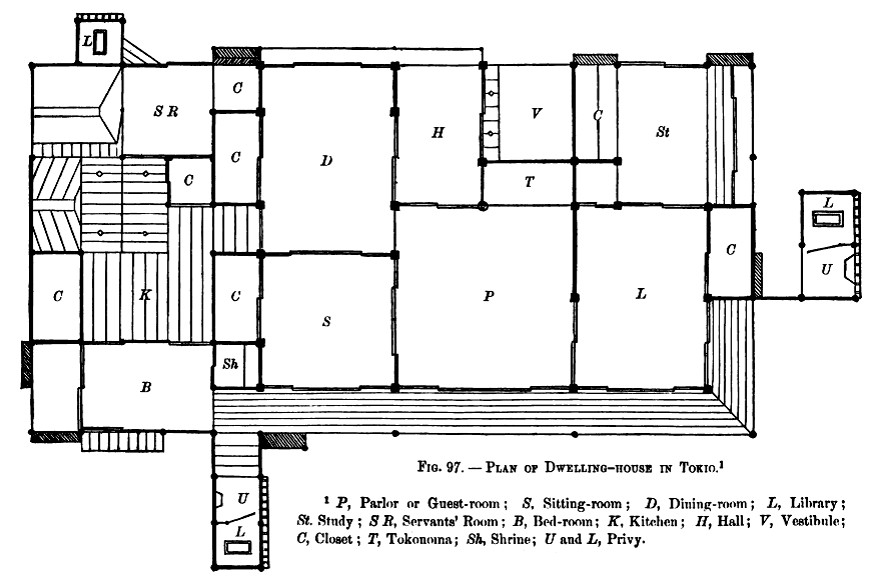 97. PLAN OF DWELLING-HOUSE IN TOKIO We are digressing, however. In the plan referred to, an idea of the size of the rooms may be formed by observing the number of mats in each room, and recalling the size of the mats, which is about three feet by six. It will be seen that the rooms are small, much smaller than those of a similar class of American houses, though appearing more roomy from the absence of furniture. The three rooms bordering the verandah and facing the garden are readily thrown into one, and thus a continuous apartment is secured, measuring thirty-six feet in length by twelve in width; and this is uninterrupted, with the exception of one small partition.2 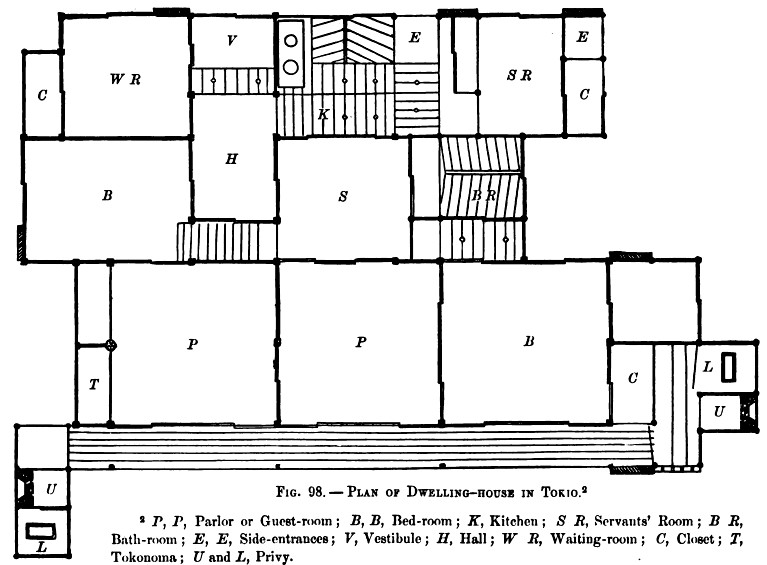 98. PLAN OF DWELLING-HOUSE IN TOKIO In the manner of building, one recognizes the propriety of constructive art as being in better taste; and in a Japanese house one sees this principle carried out to perfection. The ceiling of boards, the corner posts and middle posts and transverse ties are in plain sight. The corner posts which support the roof play their part as a decorative feature, as they pass stoutly upward from the ground beneath. A fringe of rafters rib the lower surface of the wide overhanging eaves, and these in turn rest firmly on an unhewn beam which runs as a girder from one side of the verandah to the other. The house is simply charming in all its appointments, and as a summer-house during the many long hot months it is incomparable. In the raw and rainy days of winter, however, it is not so pleasant, at least to a foreigner, though I question whether to a Japanese it is more unpleasant than the ordinary houses at home are with us, with some of the apartments hot and stifling, and things cracking with the furnace heat, while other parts are splitting with the cold; with gas from the furnace, and chimneys that often refuse to draw, and an impalpable though tangible soot and coal-dust settling on every object, and many other abominations that are too well known. The Japanese do not suffer from the cold as we do. Moreover, when in the house they clothe themselves much more warmly; and for what little artificial warmth they desire, small receptacles containing charcoal are provided, over which they warm themselves, at the same time keeping their feet warm, as a hen does her eggs, by sitting on them. Their indifference to cold is seen in the fact that in their winter-parties the rooms will often be entirely open to the garden, which may be glistening with a fresh snowfall. Their winters are of course much milder than our Northern winters. At such seasons, however, an American misses in Japan the cheerful open fireplace around which the family in his own country is wont to gather; indeed, with the social character of our family life a Japanese house to us would be in winter comfortless to the last degree. The differences between the houses of the nobles and the samurai are quite as great as the differences between these latter houses and the rude shelters of the peasant class. The differences between the interior finish of the houses of the first two mentioned classes are perhaps not so marked, as in both cases clean wood-work, simplicity of style, and purity of finish are aimed at; but the house of the noble is marked by a grander entrance, a far greater extent of rooms and passages, and a modification in the arrangement of certain rooms and passages not seen in the ordinary house. The accompanying plan of a Daimio's house (fig. 99) is from a drawing made by Mr. Miyasaki, a student in the Kaikoshia, a private school of architecture in Tokio, and exhibited with other plans at the late International Health and Education Exhibition held in London. Through the kindness of Mr. S. Tejima the Japanese commissioner, I have been enabled to examine and study these plans. The punctilious way in which guests or official callers were received by the Daimio is indicated by a curious modification of the floor of one of a suite of rooms, which is raised a few inches above the level of the other floors, forming a sort of dais. These rooms are bordered by a sort of passage-way, or intermediate portion, called the iri-kawa, which comes between the room and the verandah. To be more explicit: within the boundary of the principal guest-room there appears to be a suite of smaller rooms marked off by shōji; one of these rooms called the ge-dan has its floor on a level with the other floors of the house. The other room, called the jō-dan, has its floor raised to a height of three or four inches above that of the ge-dan, its boundary or border being marked by a polished plank forming a frame, so to speak, for the mats. On that side of the jō-dan away from the ge-dan are the tokonoma and chigai-dana. On entering such a room from the verandah one passes through the usual shōji, and then across a matted area called the irikawa, the width of one mat or more; here he comes to another line of sliding screens, which open into the apartments' just described. When the Daimio receives the calls from those who come to congratulate him on New Year's day, and other important occasions, he sits in great dignity in the jō-dan; his chief minister and other attendants occupy the iri-kawa, while the visitors enter the ge-dan, and there make their obeisance to the Worshipful Daimio Sama. In the same plan there is another suite of rooms called the kami-noma and tsugi-noma surrounded by iri-kawa, probably used for similar purposes. In this plan the close parallel lines indicate the verandahs; the thick lines, permanent partitions; and the small black squares, the upright posts. The lines of shōji and fusuma are shown by the thin lines, which with the thick lines represent the boundaries of the rooms, passage-ways, etc. 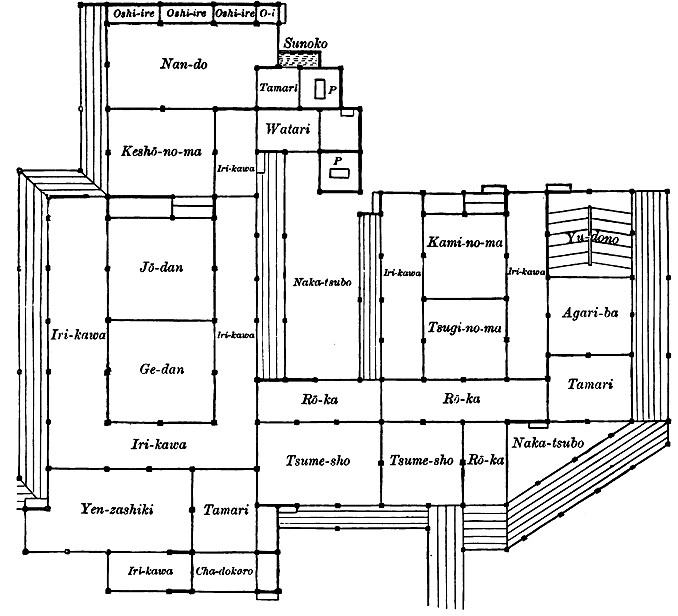 99. PLAN OF A PORTION OF A DAIMIO'S RESIDENCE3 A more minute description of the mats may be given at this point. A brief allusion has already been made to them in the remarks on house-construction. These mats, or tatami, are made very carefully of straw, matted and bound together with stout string to the thickness of two inches or more, the upper surface being covered with a straw-matting precisely like the Canton matting we are familiar with, though in the better class of mats of a little finer quality. The edges are trimmed true and square, and the two longer sides are bordered on the upper surface and edge with a strip of black linen an inch or more in width (fig. 100). 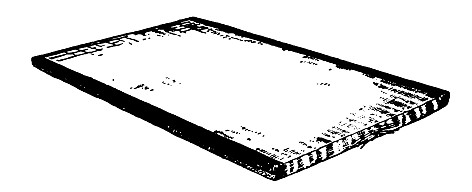 100. MAT The making of mats is quite a separate trade from that of making the straw-matting with which they are covered. The mat-maker may often be seen at work in front of his door, crouching down to a low frame upon which the mat rests. As we have before remarked, the architect invariably plans his rooms to accommodate a certain number of mats; and since these mats have a definite size, any indication on the plan of the number of mats a room is to contain gives at once its dimensions also. The mats are laid in the following numbers, two, three, four and one-half, six, eight, ten, twelve, fourteen, sixteen, and so on. In the two-mat room the mats are laid side by side. In the three-mat room the mats may be laid side by side, or two mats in one way and the third mat crosswise at the end. In the four and one-half mat room the mats are laid with the half-mat in one corner. The six and eight mat rooms are the most common-sized rooms: and this gives some indication of the small size of the ordinary Japanese room and house, the six-mat room being about nine feet by twelve; the eight-mat room being twelve by twelve; and the ten-mat room being twelve by fifteen. The accompanying sketch (fig. 101) shows the usual arrangements for these mats. 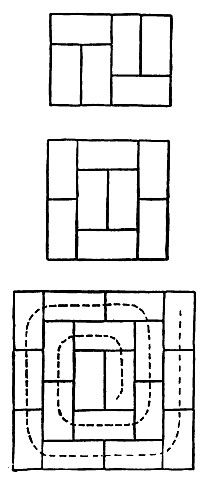 101. ARRANGEMENT OF MATS IN DIFFERENT-SIZED ROOMS In adjusting mats to the floor, the corners of four mats are never allowed to come together, but are arranged so that the corners of two mats abut against the side of a third. They are supposed to be arranged in the direction of a closely-wound spiral (see dotted line in fig. 101). The edges of the longer sides of the ordinary mats are bound with a narrow strip of black linen, as before remarked. In the houses of the nobles this border strip has figures worked into it in black and white, as may be seen by reference to Japanese illustrated books showing interiors. These mats fit tightly, and the floor upon which they rest, never being in sight, is generally made of rough boards with open joints. The mat, as you step upon it, yields slightly to the pressure of the foot; and old mats get to be slightly uneven and somewhat hard from continual use. From the nature of this soft-matted floor shoes are never worn upon it, the Japanese invariably leaving their wooden clogs outside the house, either on the stepping-stones or on the earth-floor at the entrance. The wearing of one's shoes in the house is one of the many coarse and rude ways in which a foreigner is likely to offend these people. The hard heels of a boot or shoe not only leave deep indentations in the upper matting, but oftentimes break through. Happily, however, the act of removing one's shoes on entering the house is one of the very few customs that foreigners recognize, the necessity of compliance being too obvious to dispute. In spring-time, or during a rain of long duration, the mats become damp and musty; and when a day of sunshine comes they are taken up and stacked, like cards, in front of the house to dry. They are also removed at times and well beaten. Their very nature affords abundant hiding-places for fleas, which are the unmitigated misery of foreigners who travel in Japan; though even this annoyance is generally absent in private houses of the better classes, as is the case with similar pests in our country. 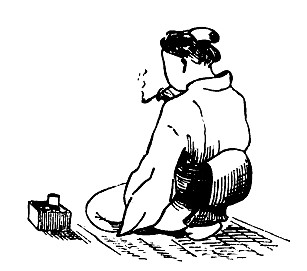 102. ATTITUDE OF WOMAN IN SITTING Upon these mats the people eat, sleep, and die; they represent the bed, chair, lounge, and sometimes table, combined. In resting upon them the Japanese assume a kneeling position, the legs turned beneath, and the haunches resting upon the calves of the legs and the inner sides of the heels; the toes being turned in so that the upper and outer part of the instep bears directly on the mats. Fig. 102 represents a woman in the attitude of sitting. In old people one often notices a callosity on that part of the foot which comes in contact with the mat, and but for a knowledge of the customs of the people in this matter might well wonder how such a hardening of the flesh could occur in such an odd place. This position is so painful to a foreigner that it is only with a great deal of practice he can become accustomed to it. Even the Japanese who have been abroad for several years find it excessively difficult and painful to resume this habit. In this attitude the Japanese receive their company. Hand-shaking is unknown, but bows of various degrees of profundity are made by placing the hands together upon the mats and bowing until the head oftentimes touches the hands. In this ceremony the back is kept parallel with the floor, or nearly so. At meal-times the food is served in lacquer and porcelain dishes on lacquer trays, placed upon the floor in front of the kneeling family; and in this position the repast is taken. At night a heavily wadded comforter is placed upon the floor; another equally thick is provided for a blanket, a pillow of diminutive proportions for a head-support, and the bed is made. In the morning these articles are stowed away in a large closet. Further reference will be made to bedding in the proper place. A good quality of mats can be made for one dollar and a half a-piece; though they sometimes cost three or four dollars, and even a higher price. The poorest mats cost from sixty to eighty cents a-piece. The matting for the entire house represented in plan fig. 97 cost fifty-two dollars and fifty cents.
Reference has already been made to the sliding screens, and as they form so important and distinct a feature in the Japanese house, a more special description of them is necessary. In our American houses a lintel is the horizontal beam placed over the door; this is cased with wood, and has a jamb or recess corresponding to the vertical recesses into which the door shuts. For the sake of clearness, we may imagine a lintel running entirely across the room from one corner to the other, and this is the kamoi of the Japanese room. The beam is not cased. On its under surface run two deep and closely parallel grooves, and directly beneath this kamoi on the floor a surface of wood shows in which are two exceedingly shallow grooves. This surface is level with the mats; and in these grooves the screens run. The grooves in the kamoi are made deep, in order that the screens may be lifted out of the floor-grooves and then dropped from the upper ones, and thus removed. In this way a suite of rooms can be quickly turned into one, by the removal of the screens. The grooves are sufficiently wide apart to permit the screens being pushed by each other. From the adjustable nature of these sliding partitions one may have the opening between the rooms of any width he desires. There are two forms of these sliding screens, the one kind, called fusuma, forming the partitions between rooms; the other kind, called shōji, coming on the outer sides of the rooms next to the verandah, and forming the substitutes for windows (fig. 103). 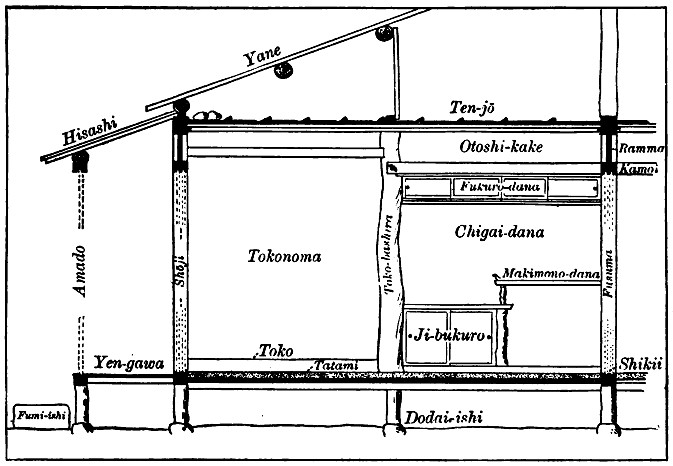 103. SECTION THROUGH VERANDAH AND GUEST-ROOM The fusuma forming the movable partitions between the rooms are covered on both sides with thick paper; and as it was customary in past times to use Chinese paper for this purpose, these devices are also called kara-kami, "China-paper." The frame is not unlike the frame used for the outside screens, consisting of thin vertical and horizontal strips of wood forming a grating, with the meshes four or five inches in width, and two inches in height. The outside frame or border is usually left plain, as is the case with most of their wood-work. It is not uncommon, however, to see these frames lacquered. The material used for covering them consists of a stout, thick, and durable paper; and this is often richly decorated. Sometimes a continuous scene will stretch like a panorama across the whole side of a room. The old castles contain some celebrated paintings on these fusuma, by famous artists. The use of heavy gold-leaf in combination with the paintings produces a decorative effect rich beyond description. In the commoner houses the fusuma are often undecorated save by the paper which covers them; and the material for this purpose is infinite in its variety, some kinds being curiously wrinkled, other kinds seeming to have interwoven in their texture the delicate green threads of some sea-weed; while other kinds still will have the rich brown sheaths of bamboo shoots worked into the paper, producing a quaint and pleasing effect. Often the paper is perfectly plain; and if by chance an artist friend comes to the house, he is asked to leave some little sketch upon these surfaces as a memento of his visit: others perhaps may have already covered portions of the surface with some landscape or spray of flowers. In old inns one has often pointed out to him the work of some famous artist, who probably paid his score in this way. While the fusuma are almost invariably covered with thick and opaque paper, it occurs sometimes that light is required in a back-room; in that case, while the upper and lower third of the fusuma retains its usual character, the central third has a shōji inserted, that is, a slight frame-work covered with white paper, through which light enters as in the outside screens. This frame is removable, so that it can be re-covered with paper when required. This frame-work is often made in ornamental patterns, geometrical or natural designs being common. In summer another kind of frame may be substituted in the fusuma, termed a yoshi-do, in which a kind of rush called yoshi takes the place of paper; the yoshi is arranged in a close grating through which the air has free access and a little light may enter. The fusuma may be entirely composed of yoshi and the appropriate frame-work to hold it. One of this kind is represented in fig. 104. The lower portion consists of a panel of dark cedar, in which are cut or perforated the figures of bats; above this panel are transverse bars of light cedar, and filling up the border of the frame is a close grating of brown reeds or rushes placed vertically; at the top is a wide interspace crossed by a single root of bamboo. The yoshi resembles miniature bamboo, the rods being the size of an ordinary wheat-straw, and having a warm brown tint. This is employed in many ways in the decoration of interiors, and the use of so fragile and delicate a material in house-finish is one of the many indications of the quiet and gentle manners of the Japanese. 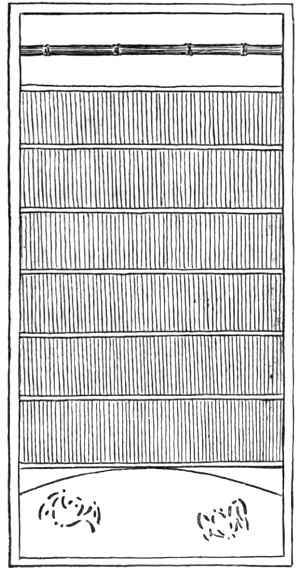 104. REED-SCREEN Oftentimes a narrow permanent partition occurs in which is an opening, the width of one fusuma, which takes the place of our swinging and slamming door. In this case the fusuma is a more solid and durable structure. The one shown in fig. 105 is of the nature of a door, since it guards the opening which leads from the hall to the other apartments of the house. A rich and varied effect is produced by the use and arrangement of light and dark bamboo and heavily-grained wood, the central panels being of dark cedar. In the vestibule one often sees sliding screens consisting of a single panel of richly-grained cedar. 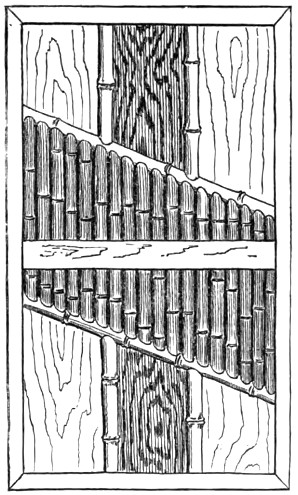 105. SLIDING PANEL Conveniences for pushing back the fusuma are secured in a variety of ways; the usual form consists of an oval or circular plate of thin metal, having a depressed area, inserted in the fusuma in about the same position a doorknob would be with us. These are called hikite, and often present beautiful examples of metalwork, being elaborately carved and sometimes enamelled. The same caprices and delights in ornamentation seen elsewhere in their work find full play in the designs of the hikite. Fig. 106 shows one from the house of a noble; its design represents an inkstone and two brushes, the brushes being silvered and tipped with lacquer, while in the recessed portion is engraved a dragon. Fig. 107 represents one made of copper, in which the leaves and berries are enamelled; the leaves green, and the berries red and white. Figs. 108 and 109 show more pretentious as well as cheaper forms, the designs being stamped and not cut by hand. Sometimes hikite are made of porcelain. In the cheaper forms of fusuma, the hikite consists of a depressed area in the paper formed by a modification of the frame itself. In illustrations of fine interiors one often notices a form of hikite from which hang two short cords of silk tied in certain formal ways, on the ends of which are tassels. From the almost universal presence of these in old illustrated books, one is led to believe that formerly the cord was the usual handle by which the fusuma was pulled back and forth, and that these gradually fell into disuse, the recessed plate of metal alone remaining. This form of hikite is rarely seen to-day, though a few of the old Daimios' houses still possess it. Fig. 110 represents two forms copied from a book entitled "Tategu Hinagata." 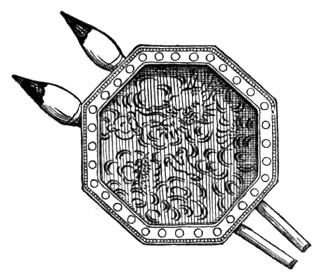 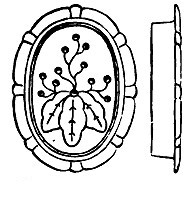 106. HIKITE 107. HIKITE 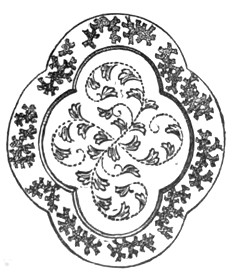 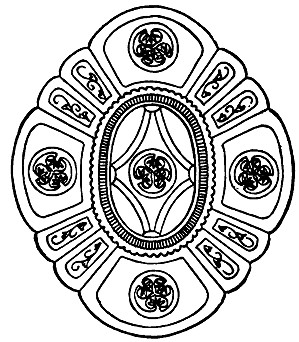 108. HIKITE 109. HIKITE 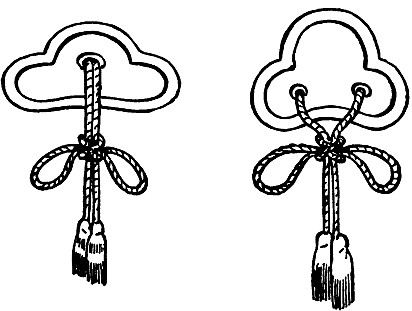 110. HIKITE WITH CORD The outside screens, or shōji, which take the place of our windows, are those screens which border the verandah, or come on that side of the room towards the exterior wall of the house. These consist of a light frame-work made of thin bars of wood crossing and matched into each other, leaving small rectangular interspaces. The lower portion of the shōji, to the height of a foot from the floor, is usually a wood-panel, as a protection against careless feet as well as to strengthen the frame. The shōji are covered on the outside with white paper. The only light the room receives when the shōji are closed comes through this paper, and the room is flooded with a soft diffused light which is very agreeable. The hikite for pushing the shōji back is arranged by one of the rectangular spaces being papered on the opposite side, thus leaving a convenient recess for the fingers. Sometimes little holes or rents are accidentally made in this paper covering of the shōji; and in the mending of these places the Japanese, ever true in their artistic feeling, repair the damage, not by square bits of paper as we should probably, but by cutting out pretty designs of cherry or plum blossoms and patching the rents with these. When observing this artistic device I have often wondered how the broken panes of some of our country houses must look to a Japanese, the repairs being effected by the use of dirty bags stuffed with straw, or more commonly by battered hats jammed into the gaps. Sometimes the frame of a shōji gets sprung or thrown out of its true rectangular shape; this is remedied by inserting at intervals in the meshes of the frame-work elastic strips of bamboo, and the constant pressure of these strips in one direction tends to bring the frame straight again. Fig. 111 illustrates the appearance of this; the curved lines representing the elastic strips. 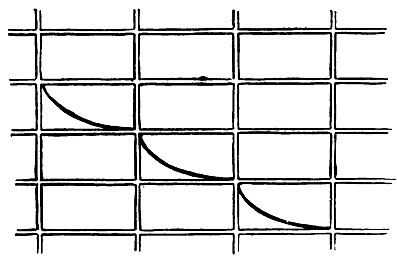 111. STRAIGHTENING SHŌJI-FRAME There are innumerable designs employed in the shōji; and in this, as in many other parts of the interior, the Japanese show an infinite amount of taste and ingenuity. Fig. 112 illustrates one of these ornamental forms. At present in the cities it is common to see a narrow strip of window glass inserted across the shōji about two feet from the floor. It seems odd at first sight to see it placed so low, until one recalls the fact that the inmates sit on the mats, and the glass in this position is on a level with their line of vision. As a general rule the designs for the shōji are more simple than those employed for certain exterior openings which may be regarded as windows, while those which cover the openings between the rooms are most complex and elaborate. Further reference, however, will be made to these in the proper place. 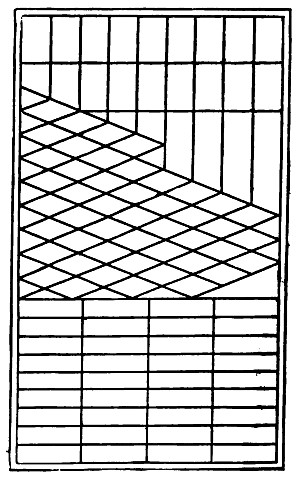 112. SHŌJI WITH ORNAMENTAL FRAME It has been necessary to anticipate the special description of the details of a room in so far as a description of the mats and screens were concerned, since a general idea of the interior could not be well understood without clearly understanding the nature of those objects which form inseparable elements of every Japanese room, and which are so unlike anything to which we are accustomed. Having given these features, it may be well to glance at a general view of the few typical rooms before examining farther into the details of their finish.
The room shown in fig. 96 gives a fair idea of the appearance of the guest-room with its two bays or recesses, the tokonoma and chigai-dana, one of which, the tokonoma, is a clear recess, in which usually hangs a picture; and in the other is a small closet and shelf, and an additional shelf above, closed by sliding doors. The sketch was taken from the adjoining room, the fusuma between the two having been removed. The grooves for the fusuma may be seen in the floor and in the kamoi overhead. The farther recess is called the tokonoma, which means literally, "bed-space." This recess, or at least its raised platform, is supposed to have been anciently used for the bed-place.4 Let us pause for a moment to consider the peculiar features of this room. The partition separating the two recesses has for its post a stick of timber, from which the bark only has been removed; and this post, or toko-bashira as it is called, is almost invariably a stick of wood in its natural state, or with the bark only removed; and if it is gnarled, or tortuous in grain, or if it presents knots or burls, it is all the more desirable. Sometimes the post may be hewn in such a way that in section it has an octagonal form, the cutting being done in broad scarfs, giving it a peculiar appearance as shown in fig. 113. Sometimes the post may have one or two branches above, which are worked into the structure as an ornamental feature. The ceiling of the tokonoma is usually, if not always, flush with the ceiling of the room, while that of the chigai-dana is much lower. The floor of the tokonoma is higher than that of the chigai-dana, and its sill may be rough or finished; and even when finished squarely, some natural surface may be left through the curvature of the stick from which it has been hewn, and which had been selected for this very peculiarity, a feature, by the way, that our carpenters would regard as a blemish. The floor of the tokonoma is in nearly every case a polished plank; the floor of the chigai-dana is also of polished wood. A large and deep tokonoma may have a mat, or tatami, fitted into the floor; and this is generally bordered with a white strip, and not with black as in the floor tatami. The tatami in this place is found in the houses of the Daimios. 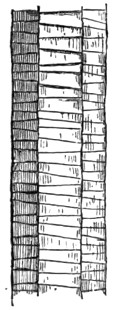 113. PORTION OF TOKO-BASHIRA Spanning the tokonoma above is a finished beam a foot or more below the ceiling, the interspace above being plastered, as are the walls of both recesses. A similar beam spans the chigai-dana at a somewhat lower level. When the cross-beam of the chigai-dana connects with the toko-bashira, as well as in the joining of other horizontal beams with the uprights, ornamental-headed nails are used. These are often of elaborately-wrought metal, representing a variety of natural or conventional forms. Figs. 114, 115, 116, and 117 present a few of the cheaper forms used; these being of cast metal, the finer lines only having been cut by hand. These nails, or kazari-kugi, are strictly ornamental, having only a spur behind to hold them into the wood.
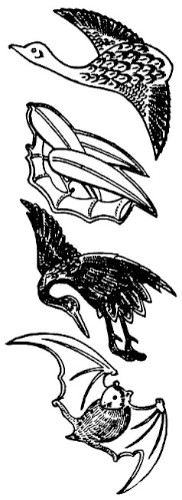 114-117. ORNAMENTAL-HEADED NAILS 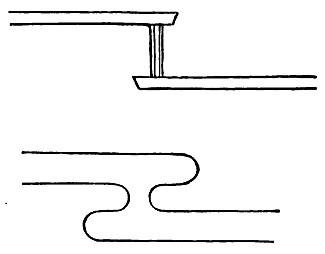 118. SHELVES CONTRASTED WITH CONVENTIONAL DRAWING OF MIST, OR CLOUDS The partition dividing these two recesses often has an ornamental opening, either in the form of a small window barred with bamboo, or left open; or this opening may be near the floor, with its border made of a curved stick of wood, as in the figure we are now describing. In the chigai-dana there are always one or more shelves ranged in an alternating manner, with usually a continuous shelf above closed by sliding doors. A little closet on the floor in the corner of the recess is also closed by screens, as shown in the figure. The wood-work of this may be quaintly-shaped sticks or highly-polished wood. 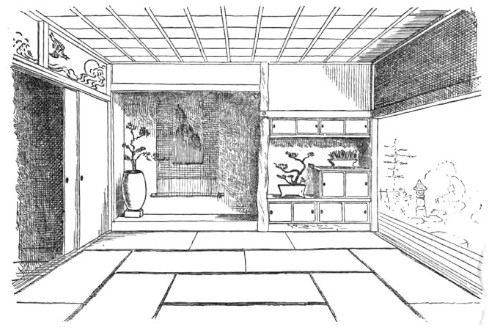 119. GUEST-ROOM This room illustrates very clearly a peculiar feature in Japanese decoration, that of avoiding, as far as possible, bi-lateral symmetry. Here are two rooms of the same size and shape, the only difference consisting in the farther room having two recesses, while the room nearer has a large closet closed by sliding screens. It will be observed, however, that in the farther room the narrow strips of wood, upon which the boards of the ceiling rest, run parallel to the tokonoma, while in the nearer room the strips run at right angles. The mats in the two rooms, while arranged in the usual manner for an eight-mat room, are placed in opposite ways; that is to say, as the mats in front of the tokonoma and chigai-dana are always parallel to these recesses, the other mats are arranged in accordance with these. In the room coming next, the arrangement of mats, while being the same, have the two mats running parallel to the line dividing the rooms, and of course the other mats in accordance with these. This asymmetry is carried out, of course, in the two recesses, which are unlike in every detail, their floors as well as the lower borders of their hanging partitions being at different levels. And in the details of the chigai-dana symmetrical arrangement is almost invariably avoided, the little closet on the floor being at one side, while a shelf supported on a single prop runs from the corner of this closet to the other side of the recess; and if another shelf is added, this is arranged in an equally unsymmetrical manner. In fact everywhere, in mats, ceiling, and other details, a two-sided symmetry is carefully avoided. 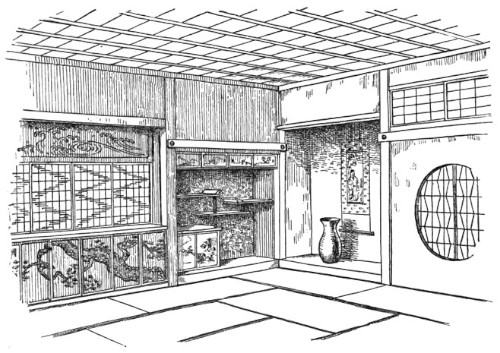 120. GUEST-ROOM, WITH RECESSES IN CORNER How different has been the treatment of similar features in the finish of American rooms! Everywhere in our apartments, halls, school-houses, inside and out, a monotonous bi-lateral symmetry is elaborated to the minutest particular, even to bracket and notch in pairs. The fireplace is in the middle of the room, the mantel, and all the work about this opening, duplicated with painful accuracy on each side of a median line; every ornament on the mantel-shelf is in pairs, and these are arranged in the same way; a single object, like a French clock, is adjusted in the dead centre of this shelf, so that each half of the mantel shall get its half of a clock; a pair of andirons below, and portraits of ancestral progenitors on each side above keep up this intolerable monotony; and opposite, two windows with draped curtains parted right and left, and a symmetrical table or cabinet between the two, are in rigid adherence to this senseless scheme. And outside the monotony is still more dreadful, even to the fences, carriage-way and flower-beds; indeed, false windows are introduced in adherence to this inane persistency in traditional methods. Within ten years some progress has been made among the better class of American houses in breaking away from this false and tiresome idea, and our houses look all the prettier for these changes. In decoration, as well, we have made great strides in the same direction, thanks to the influence of Japanese methods. While the general description just given of the tokonoma and chigai-dana may be regarded as typical of the prevailing features of these recesses, nevertheless their forms and peculiarities are infinitely varied. It is indeed rare to find the arrangement of the shelves and cupboards in the chigai-dana alike in any two houses, as will be seen by a study of the figures which are to follow. Usually these two recesses are side by side, and run at right angles with the verandah, the tokonoma almost invariably coming next to the verandah. Sometimes, however, these two recesses may stand at right angles to one another, coming in a corner of the room away from the verandah. The tokonoma may be seen also without its companion recess, and sometimes it may occupy an entire side of the room, in which case it not infrequently accommodates a set of two or three pictures. When these recesses come side by side, it is usual to have an entire mat in front of each recess. The guest of honor is seated on the mat in front of the tokonoma, while the guest next in honor occupies a mat in front of the chigai-dana. 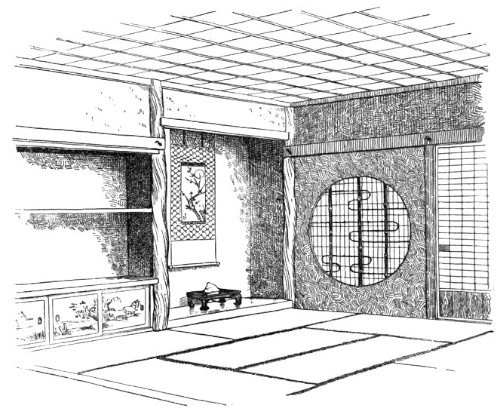 121. GUEST-ROOM, SHOWING CIRCULAR WINDOW This recess has a variety of names, according to the form and arrangement of the shelves. It is usually called chigai-dana, the word chigai meaning "different," and dana, "shelf," as the shelves are arranged alternately. It is also called usukasumi-dana, which means "thin mist-shelf," the shelves in this case being arranged in a way in which they often conventionally represent mist or clouds, as shown in their formal designs of these objects (fig. 118, in which the upper outline shows the form of shelf, and the lower outline the conventional drawing of cloud). When only one shelf is seen it may be called ichi-yo-dana; the form of the shelf suggests such names as willow-leaf shelf, fish-shelf, etc. In this recess, as we have seen, are usually shelves and a cupboard; and the arrangements of these are almost as numberless as the houses containing them, at least it is rare to see two alike. A shelf in the chigai-dana, having a rib or raised portion on its free end, is called a maki-mono-dana. On this shelf the long picture-scrolls called maki-mono are placed; the ceremonial that was also placed on one of the shelves. It was customary to place on top of the cupboard a lacquer-box, in which was contained an ink-stone, brushes, and paper. This box was usually very rich in its gold lacquer and design. In the houses of the nobles the top of the cupboard was also used to hold a wooden tablet called a shaku, an object carried by the nobles in former times, when in the presence of the Emperor. It was anciently used to make memoranda upon, but in later days is carried only as a form of court etiquette. The sword-rack might also be placed on the cupboard. In honor of distinguished guests the sword-rack was placed in the tokonoma in the place of honor; that is, in the middle of its floor, or toko, in front of the hanging picture, though if an incense-burner occupied this position, then the sword-rack was placed at one side. While these recesses were usually finished with wood in its natural state or simply planed, in the houses of the nobles this finish was often richly lacquered. Resuming our description of interiors, a peculiar form of room is shown in the house of a gentleman of high rank (fig. 119). Here the tokonoma was much larger than its companion recess, which in this case was next to the verandah. The chigai-dana was small and low, and the spaces beneath the shelves were enclosed by sliding screens forming cupboards. The tokonoma was large and deep, and its floor was covered by a mat or tatami; the flower-vase was at one side. The depth of the tokonoma is generally governed by the size of the room. The appointments of this recess are also always in proportion, the pictures and flower-vase being of large size in the one just described. In a spacious hall in Tokio is a tokonoma six feet in depth, and very wide. The flower-vases and pictures in this recess were colossal. In an adjoining room to the one last figured the tokonoma came in one corner of the room, and the chigai-dana was at right angles with it. To the right of the tokonoma was a permanent partition, in the centre of which was a circular window closed by shōji which parted right and left. The shōji may have run within the partition, or rested in a grooved frame on the other side of the wall. Above this circular window and near the ceiling was a long rectangular window, also having shōji, which could be open for ventilation. To the left of the chigai-dana was a row of deep cupboards enclosed by a set of sliding screens; above was a broad shelf, upon the upper surface of which ran shōji, which when opened revealed another room beyond. The frieze of this recess had a perforated design of waves (fig. 120). 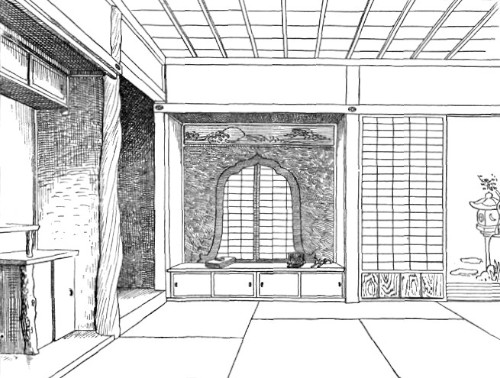 122. GUEST-ROOM, SHOWING WRITING-PLACE Severe and simple as a Japanese room appears to be, it may be seen by this figure how many features for decorative display come in. The ornamental openings or windows with their varied lattices, the sliding screens and the cupboards with their rich sketches of landscapes and trees, the natural woods, indeed many of these features might plainly be adopted without modification for our rooms. 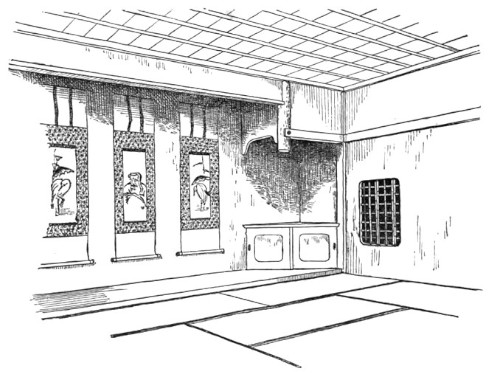 123. GUEST-ROOM, WITH WIDE TOKONOMA In another room (fig. 121) of a gentleman famous for his invention of silk-reeling machinery the tokonoma, instead of being open to the verandah, was protected by a permanent partition filling hall the side of the room bordering the verandah. In this partition was a large circular window, having a graceful bamboo frame-work. This opening was closed on the outside by a shōji, which hung on hooks and could be removed when required. In this case the honored guest, when seated in front of the tokonoma, is protected from the wind and sun while the rest of the room may be open. In the place of this partition there is often seen, in houses of the better class, a recess having a low shelf, with cupboards beneath and an ornamental window above. This is the writing-place (fig. 122); and upon the shelf are placed the ink-stone, water-bottle, brush-rest and brushes, paper-weight, and other conveniences of a literary man. Above are often suspended a bell and wooden hammer, to call the servants when required. A hanging vase of flowers is often suspended from the partition above. For want of an original sketch showing this recess I have adapted one from a Japanese book, entitled "Daiku Tana Hinagata," Vol. II. Those who have chanced to see the club rooms of the Koyokuan will recall the elaborate and beautiful panel of geometric work that fills the window of a recess of this nature. 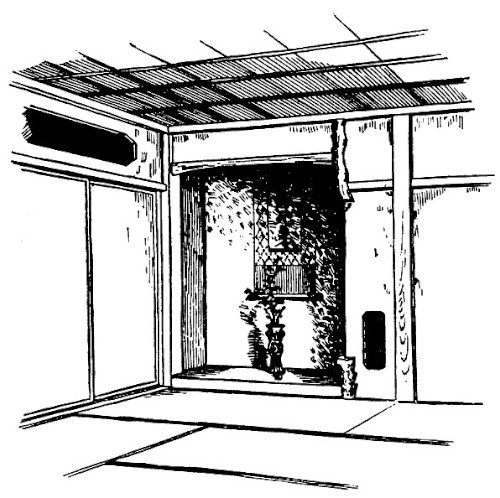 124. SMALL GUEST-ROOM In Fig. 123 the tokonoma occupies almost the entire side of the room, the chigai-dana being reduced to an angular cupboard placed in the corner and a small hooded partition hanging down from above; the small window near by, with bamboo lattice, opened into another room beyond. A. tokonoma of this kind is available for the display of sets of three or four pictures. This room was in the house of a former Daimio. In the next figure (fig. 124) we have the sketch of a small room with the tokonoma facing the verandah, and with no companion recess. The little window near the floor opened into the tokonoma, which extended behind the partition as far as the upright beam. The post which formed one side of the tokonoma was a rough and irregular-shaped stick. The treatment of cutting away a larger portion of it, though hardly constructive, yet added a quaint effect to the room; while the cross-beam of the tokonoma. usually a square and finished beam, in this case was in a natural state, the bark only being removed. 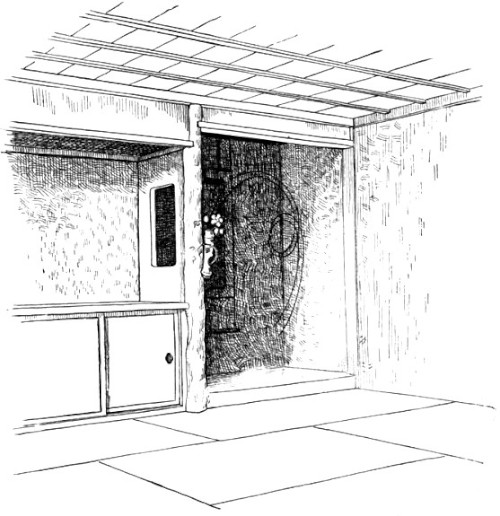 125. GUEST-ROOM OF DWELLING IN TOKIO In fig. 125 is shown a room of the plainest description; it was severe in its simplicity. Here the tokonoma, though on that side of the room running at right angles with the verandah, was in the corner of the room, while the chigai-dana was next to the verandah. The recesses were quite deep, the chigai-dana having a single broad shelf, as broad as the depth of the recess, this forming the top of a spacious closet beneath. In the partition dividing these two recesses was a long narrow rectangular opening. The little bamboo flower-holder hanging to the post of the toko-bashira had, besides a few flowers, two long twigs of willow, which were made to bend gracefully in front of the tokonoma. The character of this room indicated that its owner was a lover of the tea-ceremonies. 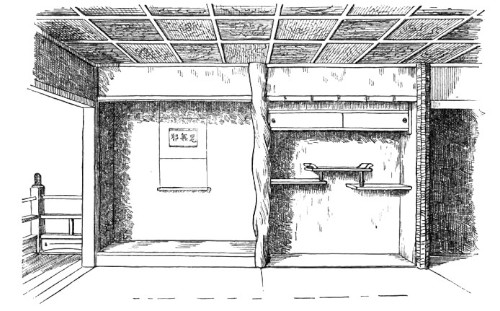 126. GUEST-ROOM IN KIYOMIDZU, KIOTO The next figure (fig. 126) is that of a room in the second story of the house of a famous potter in Kioto. This room was remarkable for the purity of its finish. The toko-bashira consisted of an unusually twisted stick of some kind of hard wood, the bark having been removed, exposing a surface of singular smoothness. The hooded partition over the chigai-dana had for its lower border a rich dark-brown bamboo; the vertical piece forming the other side of the chigai-dana was a black post hewn in an octagonal shape, with curious irregular crosscuts on the faces. The sliding doors closing the shelf in this recess were covered with gold paper. The hikite consisted of sections of bamboo let in to the surface. The plaster of both recesses was a rich, warm, umber color. The ceiling consisted of large square panels of old cedar richly grained. This room was comparatively modern, having been built in 1868. 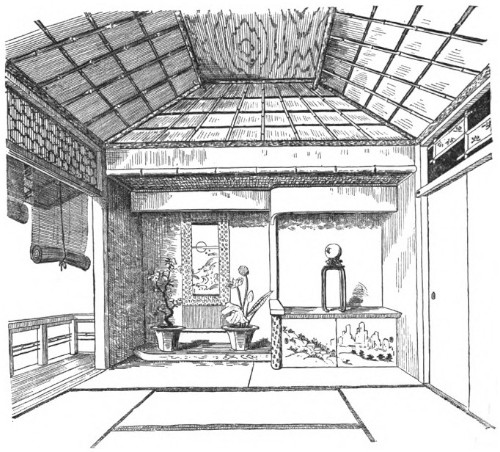 127. GUEST-ROOM OF DWELLING IN TOKIO Fig. 127 represents a room in the second story of a house in Tokio. The recesses were remarkably rich and effective. The entire end of the room formed a recess, having a plaited ceiling; and within this recess were the tokonoma and chigai-dana, each having its own hooded partition at a different level and depth, the vertical partition usually dividing these recesses being represented only by a square beam against the wall. A reference, however, to the figure will convey a clearer idea of these features than any description. The ceiling, which was quite remarkable in its way, will be described later. 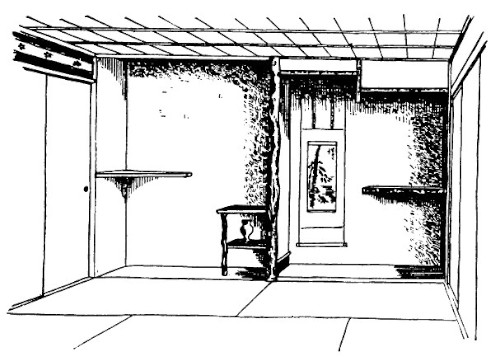 128. GUEST-ROOM OF A COUNTRY HOUSE The next interior (fig. 128) represents a room in a country house of the poorer class. The recesses were of the plainest description. The tokonoma was modified in a curious way by a break in the partition above, and beneath this modification was a shelf wrought out of a black, worm-eaten plank from some old shipwreck. The chigai-dana had an angular-shaped shelf in one of its corners, and in the other corner two little shelves supported by a post. The floor of this recess was on a level with the mats, while the floor of the tokonoma was only slightly raised above this level. 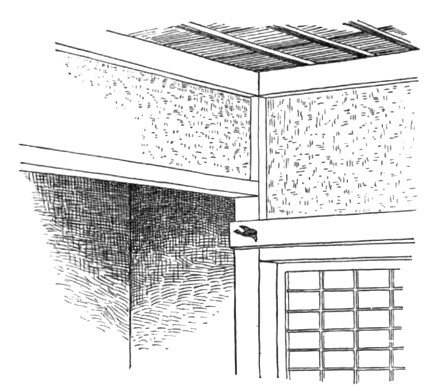 129. CORNER OF GUEST-ROOM The figures of interiors thus far given present some idea of the infinite variety of design seen in the two recesses which characterize the best room in the house. The typical form having been shown in fig. 96, it will be seen how far these bays may vary in form and structure while still possessing the distinguishing features of the tokonoma and chigai-dana. In the first recess hangs the ever present scroll, upon which may be a picture; or it may present a number of Chinese characters which convey some moral precept, or lines from some classical poem. On its floor rests the vase for flowers, a figure in pottery, an incense burner, a fragment of quartz, or other object, these being often supported by a lacquer stand. In the chigai-dana convenient shelves and closets are arranged in a variety of ways, to be used for a variety of purposes. The arrangement of the cross-ties in relation to the tokonoma and shōji is illustrated in fig. 129, which shows the corner of a room with the upper portion of the tokonoma and shōji showing. The use made of the ornamental-headed nail is seen where the kamoi joins the corner post. In houses of two stories greater latitude is shown in the arrangement of these recesses. They may come opposite the balcony, and the chigai-dana may have in its back wall an opening either circular, crescent-shaped, or of some other form, from which a pleasing view is obtained either of the garden below or some distant range beyond. Thus far we have examined the room which would parallel our drawing-room or parlor; the other rooms vary from this in being smaller, and having, of course, no recesses such as have been described. By an examination of the plans given in the first part of this chapter, it will be seen how very simple many of the rooms are, sometimes having a recess for a case of drawers or shelves; a closet, possibly, but nothing else to break the rectangular outline, which may be bounded on all sides by the sliding fusuma, or have one or more permanent partitions.
Another class of rooms may here be considered, the details of which are more severely simple even than those of the rooms just described. These apartments are constructed expressly for ceremonial tea-parties. A volume might be filled with a description of the various forms of buildings connected with these observances; and indeed another volume might be filled with the minor details associated with their different schools. In brief, the party comes about by the host inviting a company of four to attend the tea-ceremony, and in their presence making the tea in a bowl after certain prescribed forms, and offering it to the guests. To be more explicit as to the mode of conducting this ceremony, the tea is first prepared by grinding it to a fine, almost impalpable, powder. This may be done by a servant before the assemblage of the guests, or may be ordered ground from a tea shop; indeed, the host may grind it himself. This material, always freshly ground for each party, is usually kept in a little earthen jar, having an ivory cover, the well-known cha-ire of the collector. Lacquer-boxes may also be used for this purpose. The principal utensils used in the ceremony consist of a furo, or fire-pot, made of pottery (or use may be made of a depression in the floor partially filled with ashes, in which the charcoal may be placed); an iron kettle to boil the water in; a bamboo dipper of the most delicate construction, to dip out the water; a wide-mouthed jar, from which to replenish the water in the kettle; a bowl, in which the tea is made; a bamboo spoon, to dip out the powdered tea; a bamboo stirrer, not unlike certain forms of egg-beaters, by which the tea is briskly stirred after the hot water has been added; a square silk cloth, with which to wipe the jar and spoon properly; a little rest for the tea-kettle cover, made of pottery or bronze or section of bamboo; a shallow vessel, in which the rinsings of the tea-bowl are poured after washing; a brush, consisting of three feathers of the eagle or some other large bird, to dust the edge of the fire-vessel; and finally a shallow basket, in which is not only charcoal to replenish the fire, but a pair of metal rods or hibashi to handle the coal, two interrupted metal rings by which the kettle is lifted off the fire, a circular mat upon which the kettle is placed, and a small box containing incense, or bits of wood that give out a peculiar fragrance when burned. With the exception of the fire-vessel and an iron kettle, all these utensils have to be brought in by the host with great formality and in a certain sequence, and placed with great precision upon the mats after the prescribed rules of certain schools. In the making of the tea, the utensils are used in a most exact and formal manner. The making of the tea, watched by one knowing nothing about the ceremony, seems as grotesque a performance as one can well imagine. Many of the forms connected with it seem uselessly absurd; and yet having taken many lessons in the art of tea-making, I found that with few exceptions it was natural and easy; and the guests assembled on such an occasion, though at first sight appearing stiff, are always perfectly at their ease. The proper placing of the utensils, and the sequence in handling them and making the tea are all natural and easy movements, as I have said. The light wiping of the tea-jar, and the washing of the bowl and its wiping with so many peripheral jerks, the dropping of the stirrer against the side of the bowl with a click in rinsing, and a few of the other usual movements are certainly grotesquely formal enough; but I question whether the etiquette of a ceremonious dinner-party at home, with the decorum observed in the proper use of each utensil, does not strike a Japanese as equally odd and incomprehensible when experienced by him for the first time. This very brief and imperfect allusion has been made in order to explain, that so highly do the Japanese regard this ceremony that little isolated houses are specially constructed for the express purpose of entertaining tea-parties. If no house is allotted for the purpose, then a special room is fitted for it. Many books are devoted to the exposition of the different schools of tea-ceremonies, illustrated with diagrams showing the various ways of placing the utensils, plans of the tea-rooms, and all the details involved in the observances. 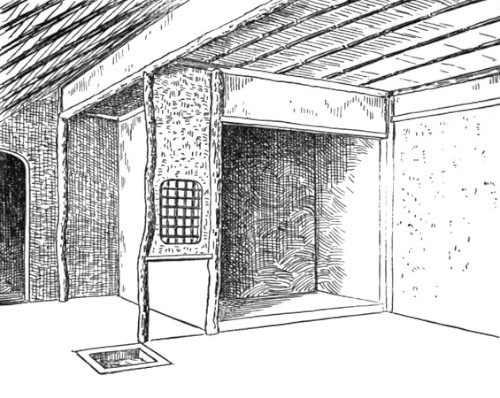 130. TEA-ROOM IN NAN-EN-JI TEMPLE, KIOTO The tea-ceremonies have had a profound influence on many Japanese arts. Particularly have they affected the pottery of Japan; for the rigid simplicity, approaching an affected roughness and poverty, which characterizes the tea-room and many of the utensils used in the ceremony, has left its impress upon many forms of pottery. It has also had an influence on even the few rustic and simple adornments allowed in the room, and has held its sway over the gardens, gateways, and fences surrounding the house. Indeed, it has had an effect on the Japanese almost equal to that of Calvinistic doctrines on the early Puritans. The one suppressed the exuberance of an art-loving people, and brought many of their decorative impulses down to a restful purity and simplicity; but in the case of the Puritans and their immediate descendants, who had but little of the art-spirit to spare, their sombre dogmas crushed the little love for art that might have dawned, and rendered intolerably woful and sepulchral the lives and homes of our ancestors; and when some faint groping for art and adornment here and there appeared, it manifested itself only in wretched samplers and hideous tomb-stones, with tearful willow or death-bed scenes done in cold steel. Whittier gives a good picture of such a home, in his poem "Among the Hills": "bookless,
pictureless,
Save the inevitable sampler hung Over the fireplace; or a mourning-piece, A green-haired woman, peony-cheeked, beneath Impossible willows; the wide-throated hearth Bristling with faded pine-boughs, half concealing The piled-up rubbish at the chimney's back."
But we are digressing. Having given some idea of the formal character of the tea-ceremonies, it is not to be wondered at that special rooms, and even special buildings, should be designed and built expressly for those observances. We give a few illustrations of the interiors of rooms used for this purpose. 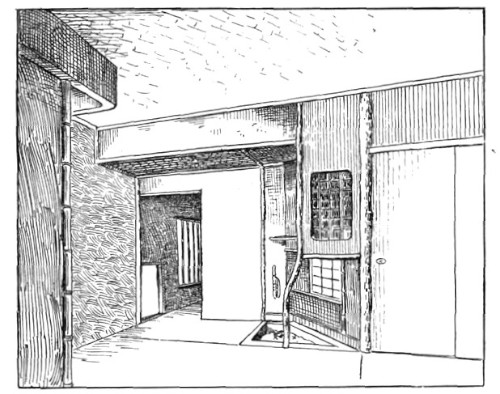 131. TEA-ROOM IN FUJIMI POTTERY, NAGOYA Fig. 130 is that of a room in Nan-en-ji temple, in Kioto, said to have been specially designed, in the early part of the seventeenth century, by Kobori Yenshiu, a famous master of tea-ceremonies, and a founder of one of its schools. The room was exceedingly small, a four and a half mat room I believe, which is the usual size. The drawing, from necessity of perspective, makes it appear much larger. The ceiling was of rush and bamboo; the walls were roughly plastered with bluish-gray clay; the cross-ties and uprights were of pine, with the bark retained. The room had eight small windows of various sizes, placed at various heights in different parts of the room; and this was in accordance with Yenshiu's taste. Only one recess, the tokonoma, is seen in the room, in which may hang at the time of a party a picture, to be replaced, at a certain period of the ceremony, by a hanging basket of flowers. The ro, or fireplace, is a depressed area in the floor, deep enough to hold a considerable amount of ashes, as well as a tripod upon which the kettle rests. 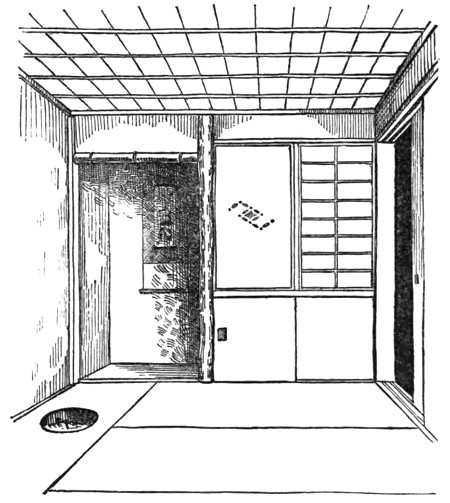 132. TEA-ROOM IN MIYAJIMA Fig. 131 represents an odd-looking tearoom, at the Fujimi pottery, in Nagoya, where tea was made and served to us by the potter's daughter. The room was simple enough, yet quite ornate compared with the one first described. The ceiling consisted of a matting of thin wood strips, bamboo and red pine being used for the cross-ties and uprights. The tokonoma, having a bamboo post, is seen at the left of the figure. The ro, in this case, was triangular. In fig. 132 is represented a view of a small tea-room at Miyajima; the chasteness of its finish is but feebly conveyed in the figure. Here the ro was circular, and was placed in a wide plank of polished wood. The room was connected with other apartments of the house, and did not constitute a house by itself. In some houses there is a special place or room adjoining the tea-room, in which the tea-utensils are kept properly arranged, and from which they are brought when tea is made, and to which they are afterwards returned with great formality. Fig. 133 represents one of these rooms in a house in Imado, Tokio. In this room the same simplicity of finish was seen. It was furnished with shelves, a little closet to contain the utensils, and a depressed area in the floor, having for its bottom a bamboo grating through which the water ran when emptied into it. Resting upon this bamboo grating were a huge pottery-vessel for water and a common hand-basin of copper. The floor was of polished wood. At the farther end was the entrance, by means of a low door, closed by fusuma. 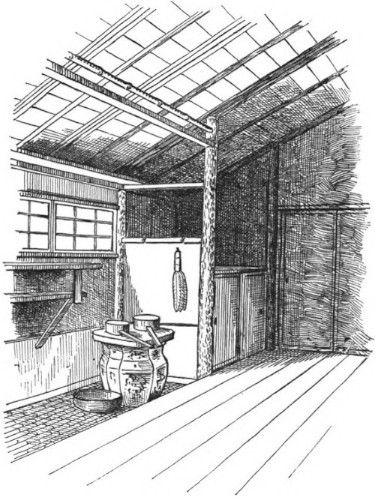 133. KITCHEN FOR TEA-UTENSILS In fig. 134 is given the view of a room in a Tokio house that was extremely ornate in its finish. The owner of the house had built it some thirty years before, and had intended carrying out Chinese ideas of design and furnishing. Whether he had got his ideas from books, or had evolved them from his inner consciousness, I do not know; certain it is, that although he had worked into its structure a number of features actually brought from China, I must say that in my limited observations in that country I saw nothing approaching such an interior or building. The effect of the room was certainly charming, and the most elaborate finish with expensive woods had been employed in its construction. It seemed altogether too ornamental for the tea-ceremonies to suit the Japanese taste. The ceiling was particularly unique; for running diagonally across it from one corner to the other was a stout bamboo in two curves, and upon this bamboo was engraved a Chinese poem. The ceiling on one side of the bamboo was finished in large square panels of an elaborately-grained wood; on the other side were small panels of cedar. Exotic woods, palms, bamboo, and red-pine were used for cross-ties and uprights. The panels of the little closet in some cases had beautiful designs painted upon them; other panels were of wood, with the designs inlaid in various colored woods, the musical instrument, the biwa, shown in the sketch, being inlaid in this way. The walls were tinted a sober brown. It was certainly one of the most unique interiors that I saw in Japan. To the right of the tokonoma the apartment opened into a small entry which led to a flight of stairs, for this room was in the second story of the house. The corner of the room, as it appeared from the tokonoma, is shown in fig. 135. The long, low window (which also shows in fig. 134) opened on the roof of the entrance below; another narrower and higher window opened on the roof of an L. In the little recess, which has for a corner-post a crooked stick, the crook forming one border of an opening in the corner, was hung a picture or a basket of flowers. 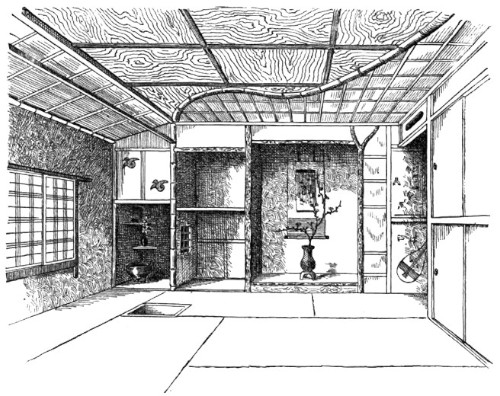 134. TEA-ROOM IN IMADO, TOKIO 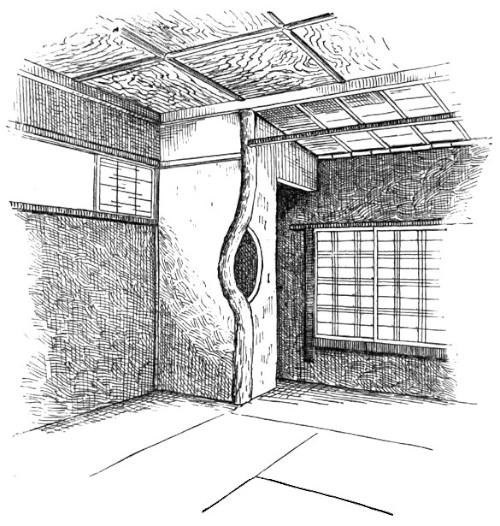 135. CORNER OF TEA-ROOM SHOWN IN FIG. 134 The second stories of shops are often used as living rooms. Fig. 136 represents a room of this nature in a shop in Kawagoye, in Musashi, nearly three hundred years old. Two long, low windows, opening on the street, were deeply recessed and heavily barred; above these openings were low deep cupboards, closed by long sliding doors. The room was dusty and unused, but I could not help noticing in this old building, as in the old buildings at home, the heavy character of the framework where it appeared in sight. Reference has been made to the fact that kura, or fire-proof buildings, are often fitted up for living-rooms. Fig. 137 (see page 160) represents the lower room of the corner building shown on page 75 (fig. 57). It has already been stated that the walls of such a building are of great thickness, and that one small window and doorway are often the only openings in the room. The walls are consequently cold and damp at certain seasons of the year. For the fitting up of such a room, to adapt it for a living-place, a light frame-work of bamboo is constructed, which stands away from the walls at a distance of two or three feet; upon this, cloth is stretched like a curtain. The frame-work forms a ceiling as well, so that the rough walls and beams of the floor above are concealed by this device. At one side the cloth is arranged to be looped up like a curtain, so that one may pass outside the drapery. 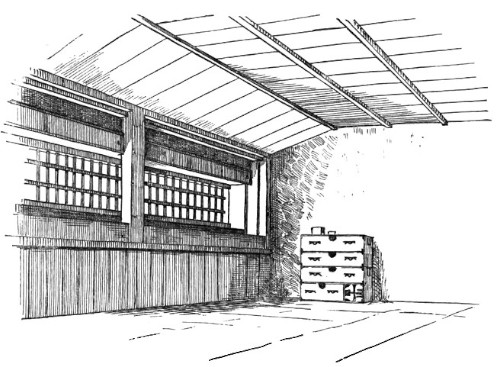 136. ROOM IN SECOND STORY OF OLD BUILDING IN KAWAGOYE, MUSASHI The owner of this apartment was an eminent antiquarian, and the walls of the room were lined with shelves and cases which were filled with old books and pictures, rare scrolls, and bric-ΰ-brac. A loft above, to which access was gained by a perilous flight of steps, was filled with ancient relics of all kinds, stone implements, old pottery, quaint writing-desks, and rare manuscripts. The cloth which formed this supplementary partition was of a light, thin texture; and when the owner went in search of some object on the other side of it, I could trace him by his candlelight as he wandered about behind the curtain. The furniture used in the room, and shown in the sketch, consisting of bookshelves, table, hibachi, and other objects, was in nearly every case precious antiques. That the rooms of kura were fitted up in this way in past times is evident in the fact that old books not only represent this method in their pictures, but special details of the construction of the framework are given. In an old book in the possession of Mr. K, published one hundred and eighty years ago, a figure of one of these frames is given, with all the details of its structure, metal sockets, key-bolts, etc., a copy of which may be seen in fig. 138. 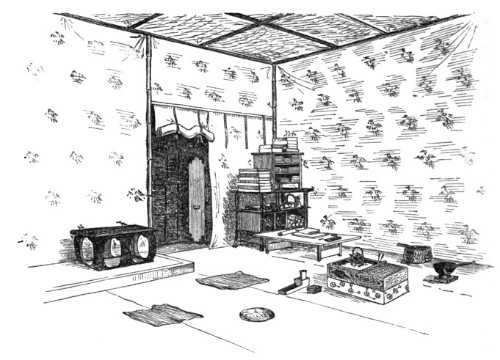 137. ROOM IN KURA FITTED UP AS A LIBRARY, TOKIO In connection with this room, and the manner of looping up the curtains at the side, I got from this scholar the first rational explanation of the meaning of the two narrow bands which hang down from the upper part of the usual form of a Japanese picture, the kake-mono. That these were survivals of useful appendages, rudimentary organs, so to speak, there could be no doubt: Mr. K told me that in former times the pictures, mainly of a religious character, were suspended from a frame. Long bands trailed down behind the picture; and shorter ones, so as not to obscure it, hung down in front. When the picture was rolled up, it was held in position by tying these bands. When the custom came to hang these pictures permanently against the wall, the long bands were finally discarded, while the shorter ones in front survived. In old books there are illustrated methods by which curtain-like screens hanging on frames were tied up in this way, the long bands being behind, and the short ones showing in front. When the wind blew through the apartment the curtains were tied up; and, curiously enough, the bands on a kake-mono are called fū-tai, or kaze-obi, which literally means "wind-bands." This is the explanation given me; but it is quite probable that large pictures hanging against the walls, when disturbed by the wind, were tied up by these bands. While the kura generally stands isolated from the dwelling-house, it is often connected with the house by a light structure of wood, roofed over, and easily demolished in case of a fire. Such an apartment may be used for a kitchen, or porch to a kitchen, or store-room for household utensils. A figure is here given (fig. 139) showing the appearance of a structure of this kind, which is lightly attached to the sides of the kura. This apartment was used as a store-room, and in the sketch is shown a wooden case, lanterns, and buckets, and such objects as might accumulate in a shed or store-room at home. 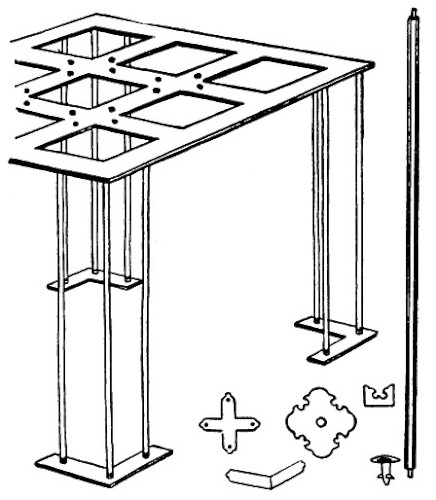 138. FRAMEWORK FOR DRAPING ROOM IN KURA. (COPIED FROM A JAPANESE WORK) The ponderous doors of the kura, which are kept permanently open, have casings of boards held in place by a wooden pin, which passes through an iron staple in the door. This casing is to protect the door which, like the walls of the kura, is composed of mud and plaster supported by a stout frame from being scarred and battered; and at the same time it is so arranged that in case of fire it can be instantly removed and the door closed. The light structure forming this porch may quickly burn down, leaving the kura intact. 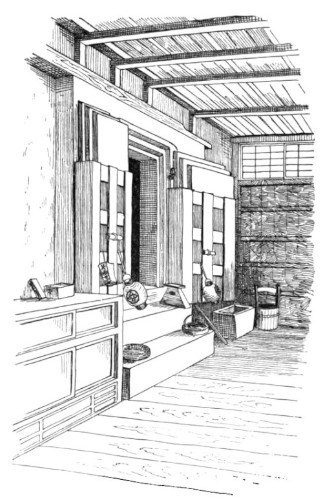 139. SPACE BETWEEN DWELLING AND KURA, ROOFED OVER AND UTILIZED AS A KITCHEN IN TOKIO Oftentimes the outside of the kura has a board-casing kept in place by long wooden strips, which drop into staples that are firmly attached to the walls of the kura. These hooks may be seen in fig. 57, though in the case of this building the wooden casing had never been applied. Casings of this nature are provided the better to preserve the walls from the action of the weather. In fig. 139 (see page 162) the kura had been originally built some fifteen feet from the main house, and subsequently the intervening space had been roofed over as shown in the drawing. The doors of the kura are ponderous structures, and are usually left open for ventilation; a heavily grated sliding door, however, closes the entrance effectually when the thick doors are left open. Fig. 140 represents the doorway of an old kura in Kioto illustrating these features. In fig. 141 the large key is the one belonging to the inner grated door, while fig. 142 shows the padlock to the outer doors. 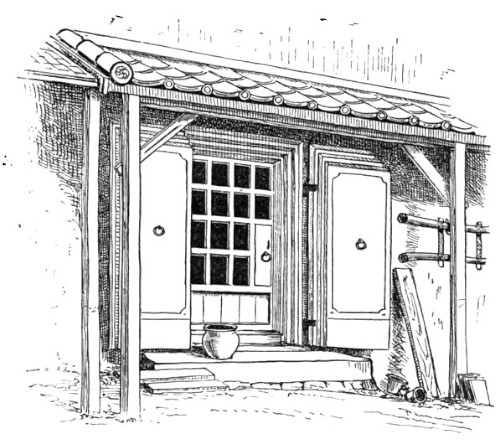 140. DOORWAY OF AN OLD KURA IN KIOTO The upper room of the kura is often utilized as a store-room, taking the place of the country attic; and one may find here bundles of dried herbs, corn, an old spinning-wheel, chests, and indeed just such objects as ultimately find a resting-place in our attics at home. In this section it would have been more systematic to deal with the tokonoma and chigai-dana separately; but in the description of interiors, it was difficult to describe them without including under the same consideration these recesses, as they form an integral part of the principal room. 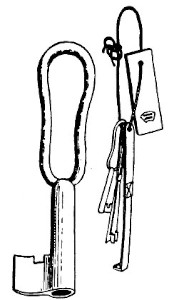  141. KEY TO KURA 142. PADLOCK TO KURA AND BUNCH OF KEYS In my remarks on house-construction, reference was made to the ceiling and the way in which it is made and held in place, the form of ceiling there described being the almost universal one throughout the country. The Japanese word for ceiling is ten-jō, literally, "heaven's well." In selecting wood for the ceiling, great care is taken to secure boards in which the grain is perfectly even and regular, with no signs of knots. A wood much prized for the ceiling, as well as for other interior finish, is a kind of cedar dug up from swamps in Hakσne, and other places in Japan. It is of a rich, warm gray or brown color; and oftentimes planks of enormous thickness are secured for this purpose. This wood is called Jin-dai-sugi, meaning "cedar of God's age." A wood called hi-no-ki is often used for ceilings. 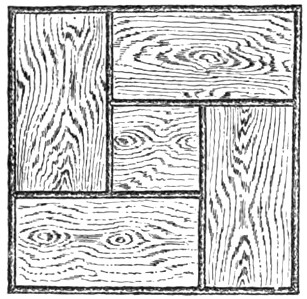 143. PANELLED CEILING It is rare to see a ceiling differing from the conventional form, consisting of light, thin, square strips as ceiling-beams, upon which rest crosswise thin planks of wood with their edges overlapping. One sees this form of ceiling everywhere, from north to south, in inns, private dwellings, and shops. This form is as universal in Japan as is the ordinary white plaster-ceiling with us. In many other forms of ceiling, however, wood of the most tortuous grain is preferred. In the little houses made for the tea-parties the ceiling is often of some rustic design, either a layer of rush resting on bamboo rafters, or thin, wide strips of wood braided or matted like basket-work. Sometimes the ceiling instead of being flat is arching; that is, the sides run up like a roof, and meet above in a flat panel, or the ceiling may be made up of panels either square or angular. A very elaborate and beautiful ceiling is seen in fig. 127 (see page 146). The structure is supposed to be in imitation of a country thatched roof. The centre panel consists of a huge plank of cedar, the irregular grain cut out in such a way as to show the lines in high-relief, giving it the appearance of very old wood, in which the softer lines have been worn away. The round sticks which form the frame for the plank, and those bordering the ceiling, as well as those running from the corners of the ceiling to the corners of the plank, are of red pine with the bark unremoved. The radiating rafters are of large yellow bamboo, while the smaller beams running parallel to the sides of the room consist of small dark-brown and polished bamboo; the body of the ceiling is made up of a brown rush, called hagi, this representing the thatch. This ceiling was simply charming; it was clean, pure, and effective; it gave the room a lofty appearance, and was moreover thoroughly constructive. Our architects might well imitate it without the modification of a single feature. The ceiling figured on page 156 (fig. 134) consisted of square panels of cedar, arranged on either side of a double curved bamboo, which ran across the ceiling diagonally from one corner of the room to another. Upon the bamboo was engraved a Chinese poem, in beautiful characters. The beauty of this ceiling consisted not only in its general quaint effect, but in the rich woods and good workmanship everywhere displayed in its construction. The same might be said of the ceiling shown in fig. 126 (see page 145); here, indeed, the whole room was like a choice cabinet. Lately, these panelled ceilings have come more into use. Fig. 143 represents a form of ceiling which may be occasionally seen, consisting of large, square planks of sugi, with a framework of bamboo or keyaki wood. It seems a little curious that the space enclosed under the roof (a garret in fact) is rarely, if ever, utilized. Here the rats hold high carnival at night; and one finds it difficult to sleep, on account of the racket these pests keep up in racing and fighting upon the thin and resonant boards composing the ceiling. The rats make a thoroughfare of the beam which runs across the end of the house from one corner to the other; and this beam is called the nedzumi-bashira, literally, "rat-post."
In my remarks on house-construction I made mention of the plaster walls, and of the various colored sands used in the plaster. There are many ways of treating this surface, by which curious effects are obtained. Little gray and white pebbles are sometimes mixed with the plaster. The shells of a little fresh-water bivalve (Corbicula) are pounded into fragments and mixed with the plaster. In the province of Mikawa I saw an iron-gray plaster, in which had been mixed the short fibres of finely-chopped hemp, the fibres glistening in the plaster; the effect was odd and striking. In the province of Omi it was not unusual to see white plastered surfaces smoothly finished, in which iron-dust had been blown evenly upon the surface while the plaster was yet moist, and, oxidizing, had given a warm brownish-yellow tint to the whole. In papering plaster-walls rice-paste is not used, as the larva of certain insects are liable to injure the surface. In lieu of this a kind of seaweed similar to Iceland moss is used, the mucilaginous portion of which forms the cement. This material is used in sizing paper, and also in the pasteboard or stiff paper which is made by sticking a number of sheets together. Plastered rooms are often papered; and even when the plaster is tinted and the plastered surface is left exposed, it is customary to use a paper called koshi-bari, which is spread on the wall to a height of two feet or more in order to protect the clothes from the plaster. This treatment is seen in common rooms.
Simple and unpretending as the interior of a Japanese house appears to be, it is wonderful upon how many places in their apparently naked rooms the ingenuity and art-taste of the cabinet-maker can be expended. Naturally, the variety of design and finish of the tokonoma and chigai-dana is unlimited save by the size of their areas; for with the sills and upright posts, the shelves and little closets, sliding-doors with their surfaces for the artists' brush, and the variety of woods employed, the artisan has a wide field in which to display his peculiar skill. The ceiling, though showing less variety in its structure, nevertheless presents a good field for decorative work, though any exploits in this direction outside the conventional form become very costly, on account of the large surface to deal with and the expensive cabinet-work required. Next to the chigai-dana in decorative importance (excepting of course the ceiling, which, as we have already seen, rarely departs from the almost universal character of thin boards and transverse strips), I am inclined to believe that the ramma receives the most attention from the designer, and requires more delicate work from the cabinet-maker. It is true that the areas to cover are small, yet the designs which may be carved or latticed, geometric designs in fret-work, or perforated designs in panel, must have a strength and prominence not shown in the other interior finishings of the room. The kamoi, or lintel, as we have seen, is a beam that runs entirely across the side of the room at the height of nearly six feet from the floor (fig. 103). On its under surface are the grooves in which the fusuma run; between this beam and the ceiling is a space of two feet or more depending, of course, upon the height of the room. The height of the beam itself from the floor, a nearly constant factor, is always lower than are our doorways, because the average height of the Japanese people is less than ours; and aggravatingly low to many foreigners is this beam, as can be attested by those who have cracked their heads against it in passing from one room to another. The space between the kamoi and the ceiling is called the ramma, and offers another field for the exercise of that decorative faculty which comes so naturally to the Japanese. This space may be occupied simply by a closed plastered partition, just as in our houses we invariably fill up a similar space which comes over wide folding doors between a suite of rooms. In the Japanese room, however, it is customary to divide this space into two or more panels, usually two; and in this area the designer and wood-worker have ample room to carry out those charming surprises which are to be seen in Japanese interiors. 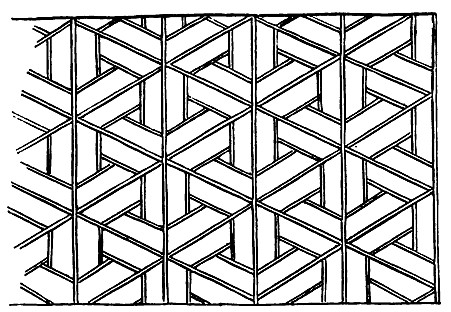 144. RAMMA IN HAKΣNE VILLAGE The designs are of course innumerable, and may consist of diaper-work and geometric designs; or each panel may consist of a single plank of wood with the design wrought out, while the remaining wood is cut away, leaving the dark shadows of the room beyond as a back-ground to the design; or the design may be in the form of a thin panel of cedar, in which patterns of birds, flowers, waves, dragons, or other objects are cut out in perforated work. Fret-work panels are very often used in the decoration of the ramma, of designs similar to the panels now imported from Japan; but the figures are worked out in larger patterns.  145. BAMBOO RAMMA Light and airy as the work seems to be, it must nevertheless be strongly made, as it is rare to see any displaced or broken portions in panels of this nature. The design represented in fig. 144 is from a ramma in an old house in the village of Hakσne. The room was very large, and there were four panels in the ramma, which was nearly twenty-four feet long. A light trellis of bamboo is a favorite and common device for this area. Fig. 145 gives a simple form of this nature, which may be often seen. In a house in Tokio we saw a similar design carried out in porcelain (fig. 146), the central vertical rod having a dark-blue glaze, while the lighter horizontal rods were white in color. It should be understood that in every case the interspaces between the designs, except in the perforated ones, are freely open to the next room. By means of these open ramma much better ventilation of the rooms is secured when the fusuma is closed. A combination of perforated panels and a grating of bamboo is often seen (fig. 147). 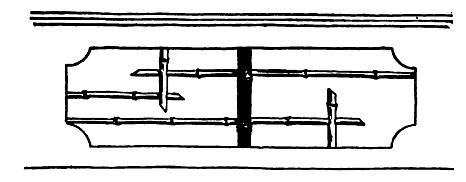 146. PORCELAIN RAMMA IN TOKIO The ramma requiring great skill in design and execution are those in which the wood-carver, having his design drawn upon a solid plank, cuts away all the wood about it, leaving the design free; and this is then delicately wrought.  147. RAMMA OF BAMBOO AND PERFORATED PANEL In an old house at Gojio, Yamato, is a ramma having a single panel the length of the room. Fig. 148 illustrates this design, which consists of chrysanthemums supported on a bamboo trellis, and was carved out of a single plank, the flowers and delicate tracery of the leaves being wrought with equal care on both sides; in fact, the ramma in every case is designed to be seen from both rooms. I have often noticed that in quite old houses the ramma was of this description. In an old house at Yatsushiro, in Higo, I saw a very beautiful form of this nature (fig. 149). The ramma was divided into two panels, and the design was continuous from one panel to the other. It represented a rustic method of conducting water by means of wooden troughs, propped up by branched sticks, and sticks tied together. The representation of long leaves of some aquatic plant, with their edges ragged by partial decay, was remarkably well rendered. The plank out of which the design was wrought must have been less than an inch in thickness, and yet the effect of relief was surprising. A white substance like chalk filled the interstices of the carving, giving the appearance that at one time the whole design had been whitened and the coloring matter had subsequently worn away. The house was quite old, and the work had been done by a local artist. It is a remarkable fact, and one well worth calling attention to, that in the smaller towns and villages, in regions far apart, there seem to be artistic workmen capable of designing and executing these graceful and artistic carvings, for such they certainly are. Everywhere throughout the Empire we find good work of all kinds, and evidence that workmen of all crafts have learned their trades, not "served" them, and are employed at home. In other words, the people everywhere appreciate artistic designs and the proper execution of them; and, consequently, men capable in their various lines find their services in demand wherever they may be. I do not mean to imply by this general statement that good workmen in Japan are not drawn to the larger cities for employment, but rather that the smaller towns and villages everywhere are not destitute of such a class, and that the distribution of such artisans is far more wide and general than with us. And how different such conditions are with us may be seen in the fact that there are hundreds of towns and thousands of villages in our country where the carpenter is just capable of making a shelter from the weather; and if he attempts to beautify it but we will not awaken the recollection of those startling horrors of petticoat scallops fringing the eaves and every opening, and rendered, if possible, more hideous by the painter. Throughout the breadth and length of that land of thirty-six million people men capable of artistic work, and people capable of appreciating such work, abound. In our land of fifty-five millions one has to seek the great centres of population for similar work, for elsewhere the good work and its appreciation are exceptional.  148. CARVED-WOOD RAMMA IN GOJIO VILLAGE, YAMATO  149. CARVED-WOOD RAMMA IN TOWN OF YATSUSHIRO, HIGO At Nagoya, in the house of a poor man, I saw a simple and ingenious form of ramma, in which two thin boards, one of light and the other of dark cedar, had been cut in the form of mountain contours. These were placed in juxtaposition, and from either side the appearance of two ranges of mountains was conveyed. Fig. 150 gives a faint idea of the appearance of this simple ramma. There are many suggestions in the decoration and utilization for ventilating rooms through certain portions of the frieze, which might be adopted with advantage in the finish of our interiors.  150. RAMMA, COMPOSED OF TWO THIN BOARDS, IN NAGOYA, OWARI As the room, when closed, receives its light through the shōji, the windows proper that is, certain openings in permanent partitions which may be regarded as windows have in most cases lost their functional character, and have become modified into ornamental features merely, many of them being strictly decorative, having none of the functions of a window whatever. These openings assume an infinite variety of forms, and appear in the most surprising places in the room. They may be placed low down near the floor, or close to the ceiling; indeed, they occur between the rooms when permanent partitions are present, and similar openings may be seen in the partition which separates the tokonoma from the chigai-dana. A window often occurs in a partition that continues some little distance beyond the outer edge of the tokonoma. This window is usually square, and is closed by a shōji. The upper cross-piece of the shōji-frame projects at each end, so that it may be hung in place on iron hooks (fig. 151). If the window comes near the tokonoma the shōji is hung on the outside of the room, as its appearance in this way is better from within. If it occurs in a partition near the chōdzu-bachi, the shōji is hung inside the room. Sometimes the shōji rests on grooved cleats or bars, which are fastened above and below the window, and oftentimes it runs inside the partition, that is, in a partition that is double. The shōji in this case is often made in two portions, and parts to the right or left. The frame-work of the shōji forming the windows is often a marvel of exquisite taste. The designs are often geometric figures, as in fig. 152; though other designs are seen, as in fig. 153, representing a mountain. These designs, being made of very thin strips of white pine, it would seem that in such examples portions of the frame-work must have been fastened to the paper to keep them in place, for there are no means of sustaining such a frame in position without some such method. 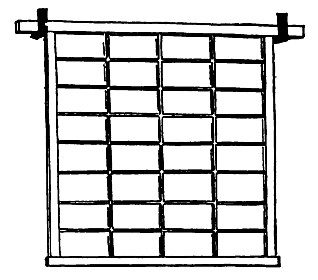 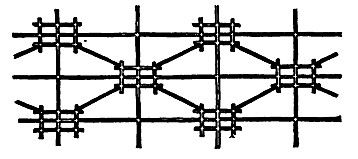 151. SHŌJI FOR WINDOW 152. SHŌJI-FRAME FOR WINDOW At Nagoya, in an old house, I saw a remarkable partition of dark cedar, in which a circular window, five feet in diameter, was occupied by a panel of thin cedar, in which was a perforated design of waves; the drawing was of the most graceful description. The curious, formal, curled tongues of water, like young sprouting ferns, the long graceful sweep of the waves, and the circular drops suspended above the breaking crests presented a charming effect, as the light coming through from the outside illuminated these various openings. When these windows occur in the second story they are arranged to overlook some pleasant garden or distant landscape; for this purpose the window is usually circular, though it may be in the shape of the crescent moon, or fan-shaped; indeed, there seems to be no end to designs for these apertures. Openings of this nature between rooms may or may not have shōji, but they always have a lattice-work of bamboo, or some other material, arranged in certain ornamental ways. The outside windows not only have the shōji, but may have an ornamental lattice-work as well. In fig. 121 the large circular window next the tokonoma had a lattice-work of bamboo arranged in an exceedingly graceful design. 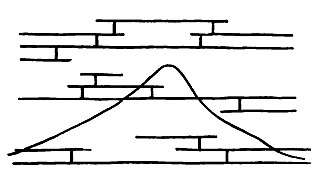 153. SHŌJI-FRAME FOR WINDOW 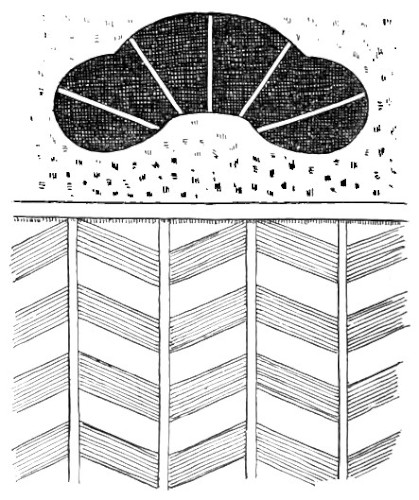 154.
WINDOW 154.
WINDOW
Great attention is devoted to the window which comes in the recess used for writing purposes. The frame of this window may be lacquered, and the lattice-work and shōji are often marvels of the cabinet-maker's art. Windows of curious construction are often placed in some passage-way or space at the end of the verandah leading to the lavatory, when one exists. The accompanying figure (fig. 154) shows a window of this nature, seen from the outside; the bars were of iron, and below the opening the wood-finish consisted of alternate panels of cedar-bark and light wood. There are hundreds of forms of these windows, or mado, as they are called. The few to which allusion has been made serve to give one some idea of the almost entirely ornamental character of these openings. It is worthy of note that each form has its appropriate name, and books are specially prepared, giving many designs of windows and their modes of construction. In the chapter on Gardens a few descriptions and sketches are given of other forms of windows belonging to summer-houses.
The open character of the Japanese house has caused the development of a variety of forms of portable screens, bamboo shades, curtains, and the like, upon which much ingenuity of construction and an infinite amount of artistic talent have been expended. The biyō-bu, or folding screens, are too well known to require more than a passing allusion. These consist of a number of panels or folds covered on both sides with stout paper. A narrow border of wood forms an outer frame, and this may be plain or lacquered. The end folds have the corners as well as other portions of its frame decorated with wrought metal pieces. Just within the frame runs a border of brocade of varying width, and on its inner edge a narrow strip of brocade; within this comes the panel or portion to receive the artist's efforts. Each fold or panel may have a separate picture upon it; or, as is most usually the case, a continuous landscape or composition covers the entire side of the screen. Many of the great artists of Japan have embodied some of their best works on screens of this kind, and the prices at which some of these are held are fabulous. The rich and heavily-gilded screens now so rare to obtain are marvels of decorative painting. While the front of the screen may have a broad landscape, the back may be simply a plain gold surface, or have some sketchy touches of bamboo, pine, etc., in black. I have been told that the gold-leaf was so thick on many of the old screens, that the sacrilege has often been committed of destroying them for the gold contained on their surfaces. The six-panelled gold-screen is, beyond all question, the richest object of household use for decorative purposes ever devised. There certainly is no other device in which so many decorative arts are called into play. The rich lacquered frame, the wrought metallic mountings, the border of gold brocade, and the great expanse for the artist's brush (for when both sides of a six-fold screen is decorated, an area is obtained nearly five feet in height and twenty-four feet in length) give great variety for richness of adornment. The rich, dead gold-leaf with which it is gilded softens the reflections, and gives a warm, radiant tone to the light. Its adjustable nature permits it to display its painting in every light. We refer now, of course, to the genuine old gold screens which came in sets of two. 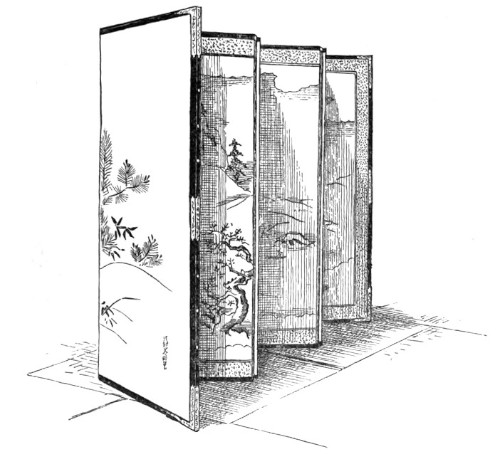 155. BIYŌ-BU, OR FOLDING SCREEN One possessing a set of these screens may consider himself particularly fortunate. The one figured (fig. 155) has depicted upon it a winter scene painted by Kano Tsunenobu, and is nearly one hundred and seventy years old; the companion of this has represented upon it a summer scene, by the same artist. On the reverse sides are painted with bright and vigorous touches the bamboo and pine. Fig. 156 shows one corner of the screen-frame with its metal mounting. These screens may have two folds, or three, or even six, as in this case. A set of screens when not in use are enclosed in silk bags, and then placed in a long, narrow wooden box (fig. 157). This box, like other articles of household use, such as bureaus and chests of drawers, has long hanging iron handles, which when turned upwards project above the level of the top, forming convenient loops through which a stick may be passed, and thus in case of fire may be easily transported upon the shoulders of men. When the screen is unfolded and placed on the floor, various devices are provided to prevent the end panels being swayed by the wind. These devices may be in the shape of some metal figure which acts as a check, or a heavy weight of pottery made in the shape shown in fig. 158, the end of the screen fitting into the slot in the weight. 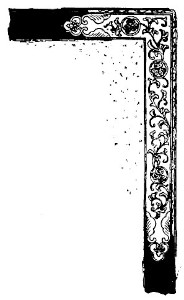  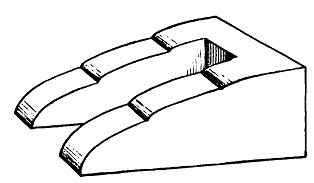 156. WROUGHT METALLIC 157. SCREEN-BOX 158. FOOT-WEIGHT MOUNTING OF SCREEN FRAME FOR SCREEN On certain festival days, it is customary for the people bordering the wider thoroughfares to throw open their houses and display their screens; and in Kioto, at such times, one may walk along the streets and behold a wonderful exhibition of these beautiful objects. A screen peculiar to Kioto, and probably farther south, is seen, in which panels of rush and bamboo split in delicate bars are inserted in each leaf of the screen. Such a screen when spread admits a certain amount of light as well as air, and may be used in summer. A low screen of two folds, called a furosaki biyō-bu is placed in front of the furo, or fire-vessel, used for boiling water for tea. The purpose of this is to screen the furo from the wind and prevent the ashes from being blown about the room. Sometimes these screens are made in a rigid form of wood, with the wings at right angles, the panels being of rush; and in the corner of the screen a little shelf is fixed, upon which the tea-utensils may be placed. Such an one is here figured (fig. 159); there are many designs for this kind of screen. 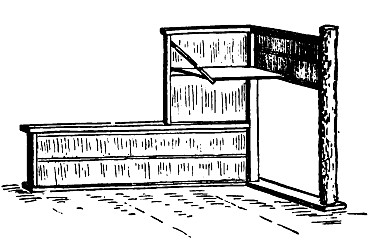 159. FUROSAKI BIYŌ-BU In the old-fashioned genka, or hall-way, there stands a solid screen of wood with heavy frame, supported by two transverse feet. This screen is called a tsui-tate, and is an article of furniture belonging to the hall. It is often richly decorated with gold lacquer, and is usually much lower in height than the ordinary screen. In old Japanese picture-books this form is often represented. Diminutive models of the tsui-tate (fig. 160) are made in pottery or porcelain, and these are for the purpose of standing in front of the ink-stone to prevent the mats from being spattered when the ink is rubbed. In another form of tsui-tate a stand is made having uprights placed in such a way that a screen covered with stout paper or a panel may be placed upon the stand and held in a vertical position by these uprights, as shown in fig. 161. 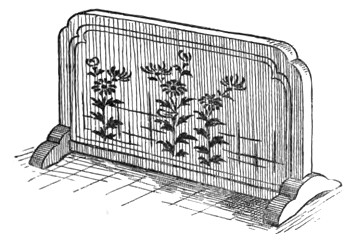 160. MODEL OF TSUI-TATE IN POTTERY When the shōji are removed, and the room thrown wide open to the light and air, curtains composed of strips of bamboo or rush are used as sun-screens; these are generally hung up just below the edge of the supplementary roof or hisashi, or may be suspended just outside the room. They can be rolled up and tied, or dropped to any desired length. These curtains may be either plain or have traced upon them delicate designs of vines or gourds, or conventional patterns. These designs are produced either by the joints on the bamboo being adjusted to carry out a zigzag or other design, as shown in fig. 162 (A), or else the thin strips of bamboo may have square notches cut out from their lower edges as in fig. 162 (B). In this case the shade of the room within gives the necessary back-ground to bring out the design as shown in fig. 163. These devices are called noren; if made of bamboo, they are called sudare. In illustrated books there is often seen figured a screen such as is shown in fig. 164. This consists of a lacquered stand, from which spring two upright rods, which in turn support a transverse bar not unlike some forms of towel-racks; dependent from this is a curtain of cloth, which is long enough to sweep the floor. I have never seen this object, though it is probably in use in the houses of the Daimios. 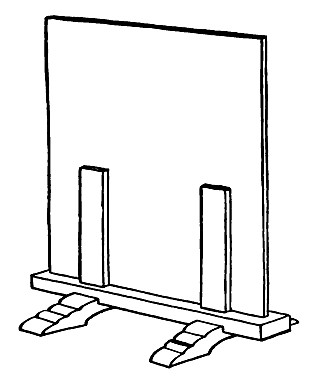 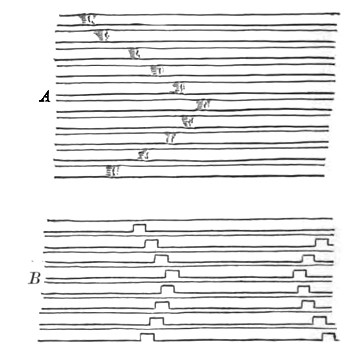 161. TSUI-TATE 162. BAMBOO CURTAINS A screen or curtain is often seen in doorways and passageways, consisting of a fringe of cords, upon which have been strung like beads short sections of bamboo, with black seeds at intervals. A portion of one of these fringed curtains is illustrated in fig. 165. Such a curtain has the advantage not only of being a good screen, but the inmates may pass through it, so to speak, without the necessity of lifting it. There are many forms of this curtain to be seen, and at present the Japanese are exporting a variety of delicate ones made of glass beads and sections of rushes. 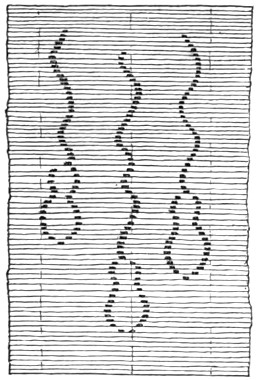 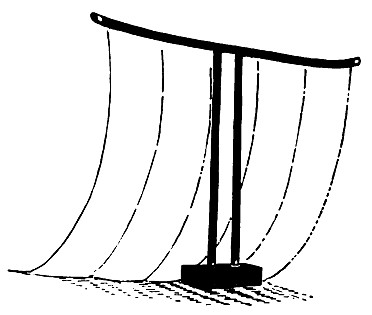 163. BAMBOO CURTAIN 164. CURTAIN-SCREEN Cloth curtains are used at the entrance to the kitchen, and also to screen closet-like recesses. The cloth is cut at intervals, leaving a series of long flaps. This curtain is not readily swayed by the wind, and can easily be passed through as one enters the room (fig. 166). In front of the Japanese shop one may see a similar form of curtain slit at intervals, so that it may not be affected by ordinary winds. 165. FRINGED CURTAIN 166. SLASHED CURTAIN There are doubtless many other forms of screens and curtains not here enumerated, but most of those described present the common forms usually observed. ____________________ 1 An odor which at home we recognize as "Japanesy," arising from the wood-boxes in which Japanese articles are packed. 2 In the plan (fig. 97) P is an eight-mat room; D and L are six-mat rooms; S is a four and one-half mat room; B, H, and St. are three-mat rooms; S and V are two-mat rooms. In the plan (fig. 98) P, P, and B are eight-mat rooms; B is a six-mat room; W and S, are four and one-half mat rooms; H, and S R, are three-mat rooms. 3 The following is a brief explanation of the names of the rooms given in plan fig. 99: Agari-ba (Agari, "to go up;" ba, "place"), Platform, or place to stand on in coming out of the Bath. Cha-dokoro, Tea-place; Ge-dan, Lower Step; Jo-dan, Upper Step; Iri-kawa, Space between verandah and room; Kami-no-ma, Upper place or room; Tsugi-no-ma, Next place or room; Kesho-no-ma, Dressing-room (Kesho, "adorning the face with powder"). Nan-do, Store-room; Naka-tsubo, Middle space; Oshi-ire, Closet (literally, "push," "put in"); Ro-ka, Corridor, Covered way; Tamari, Ante-chamber; Tsume-sho, Waiting-room for Servants; Yu-dono, Bath-room; Yenzashiki, End parlor; Watari, "to cross over;" Sunoko. Bamboo shelf or platform. 4 See chapter viii. for further considerations regarding the matter. |